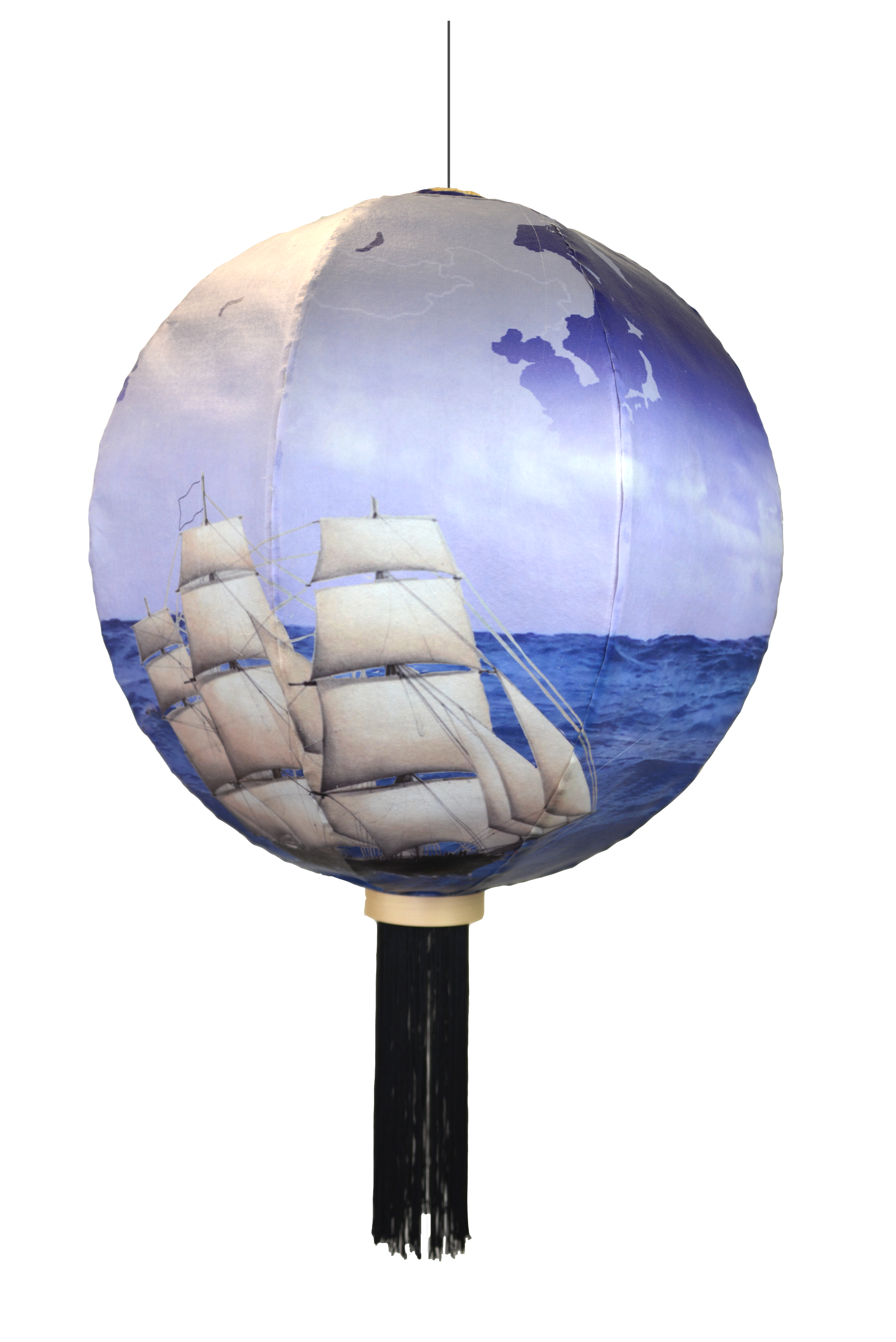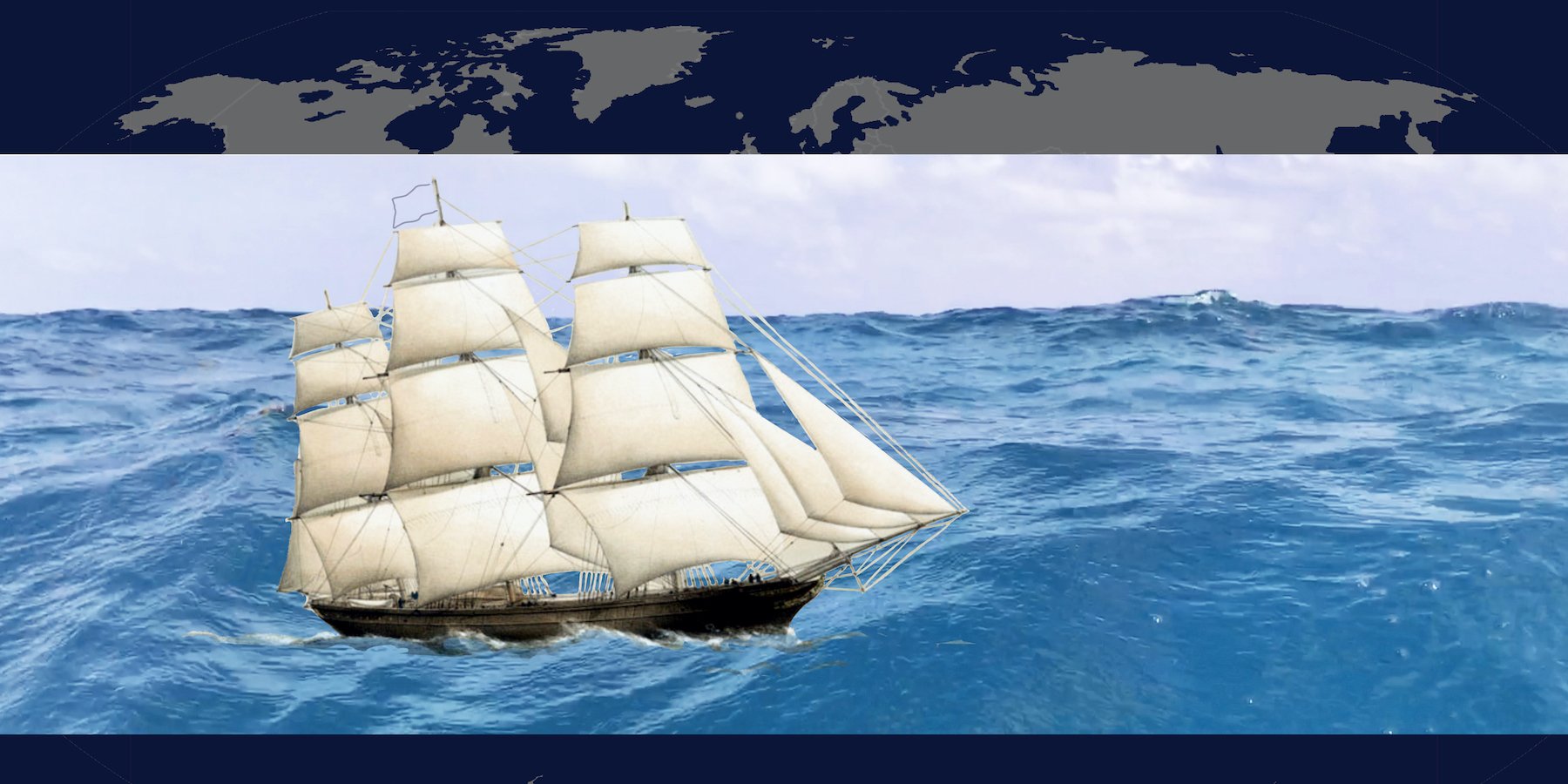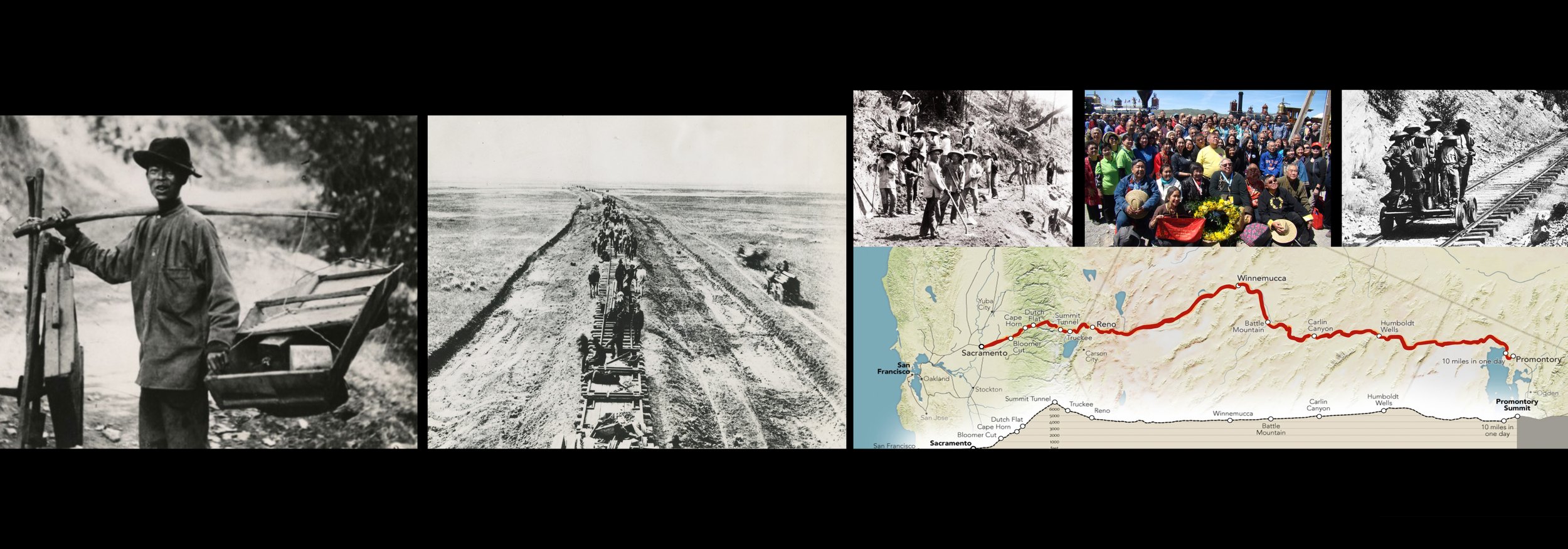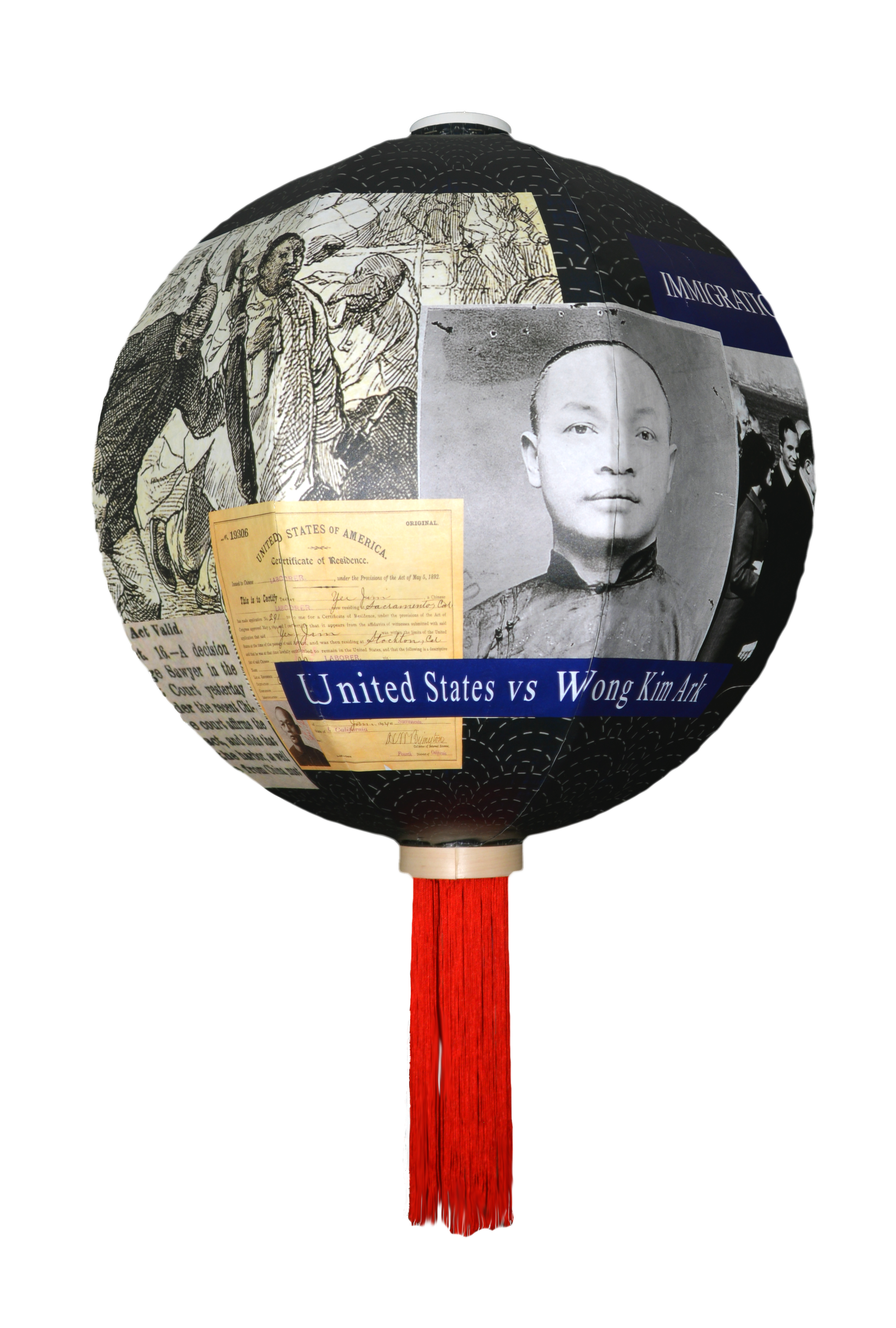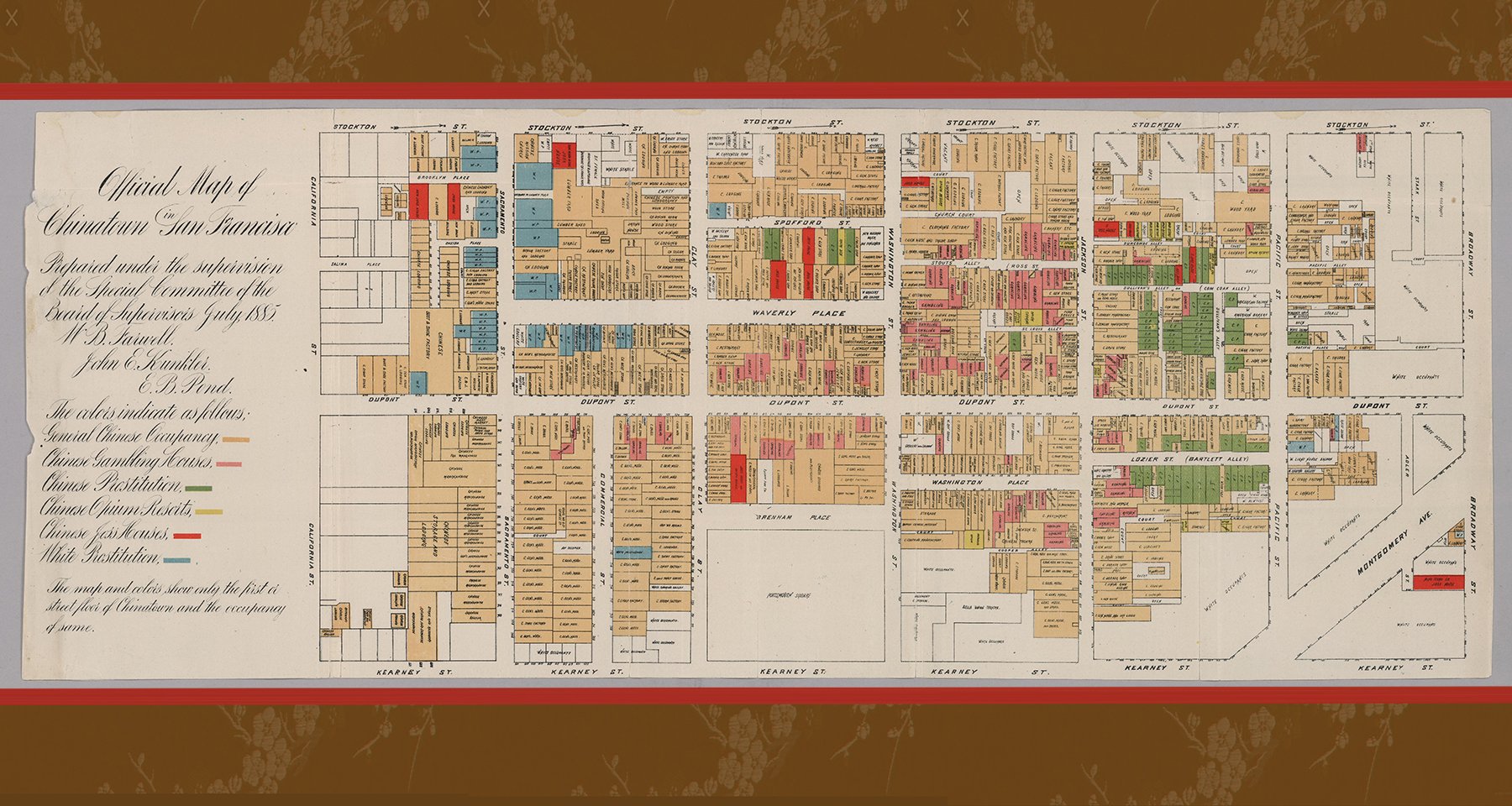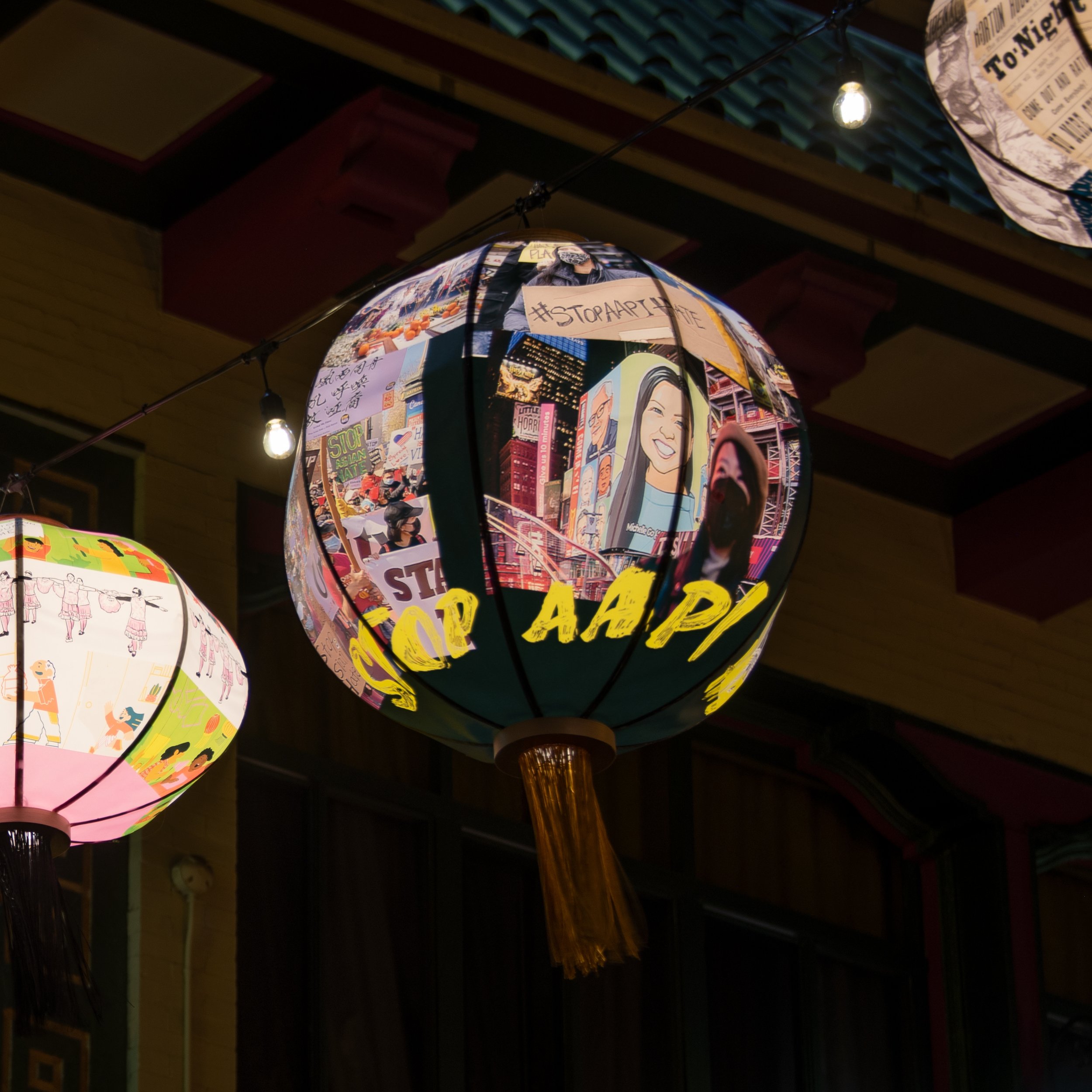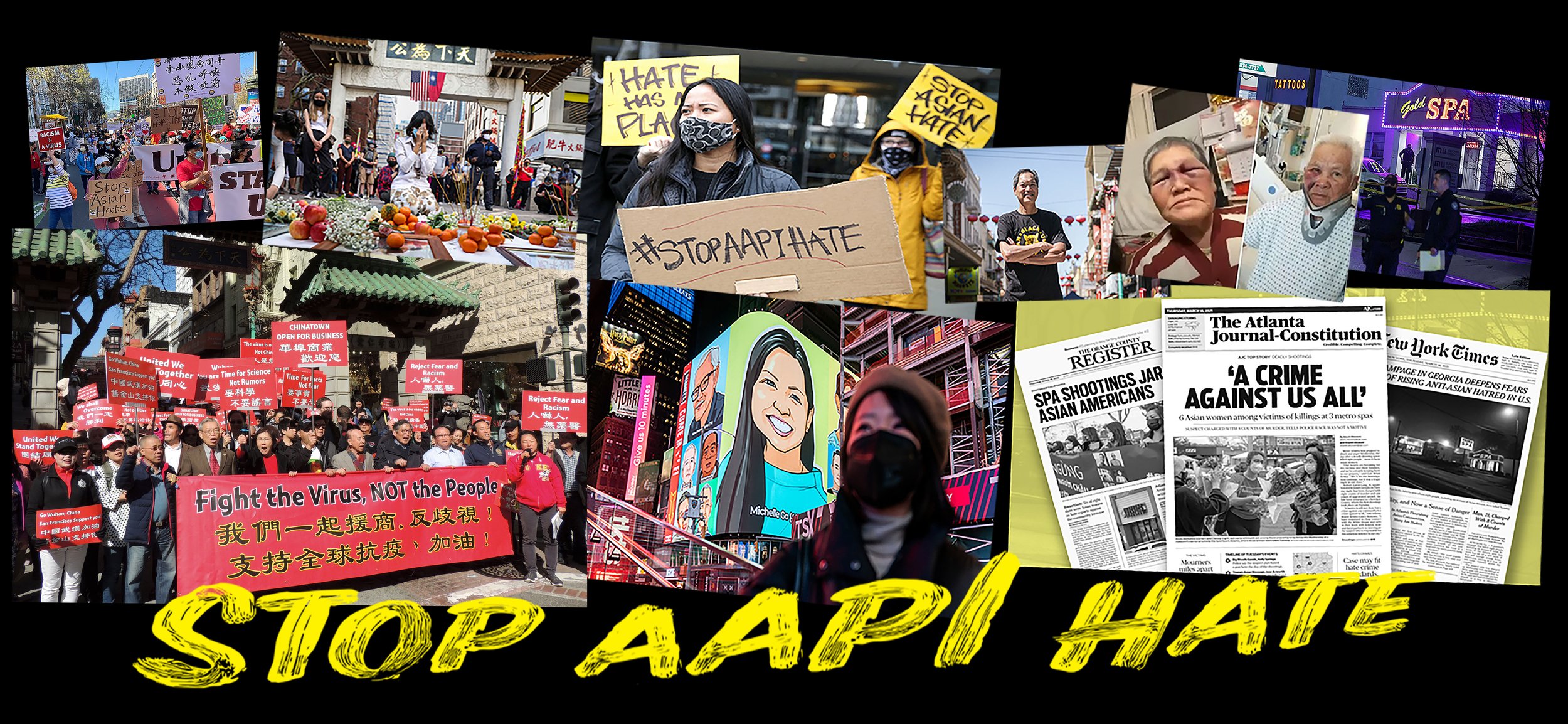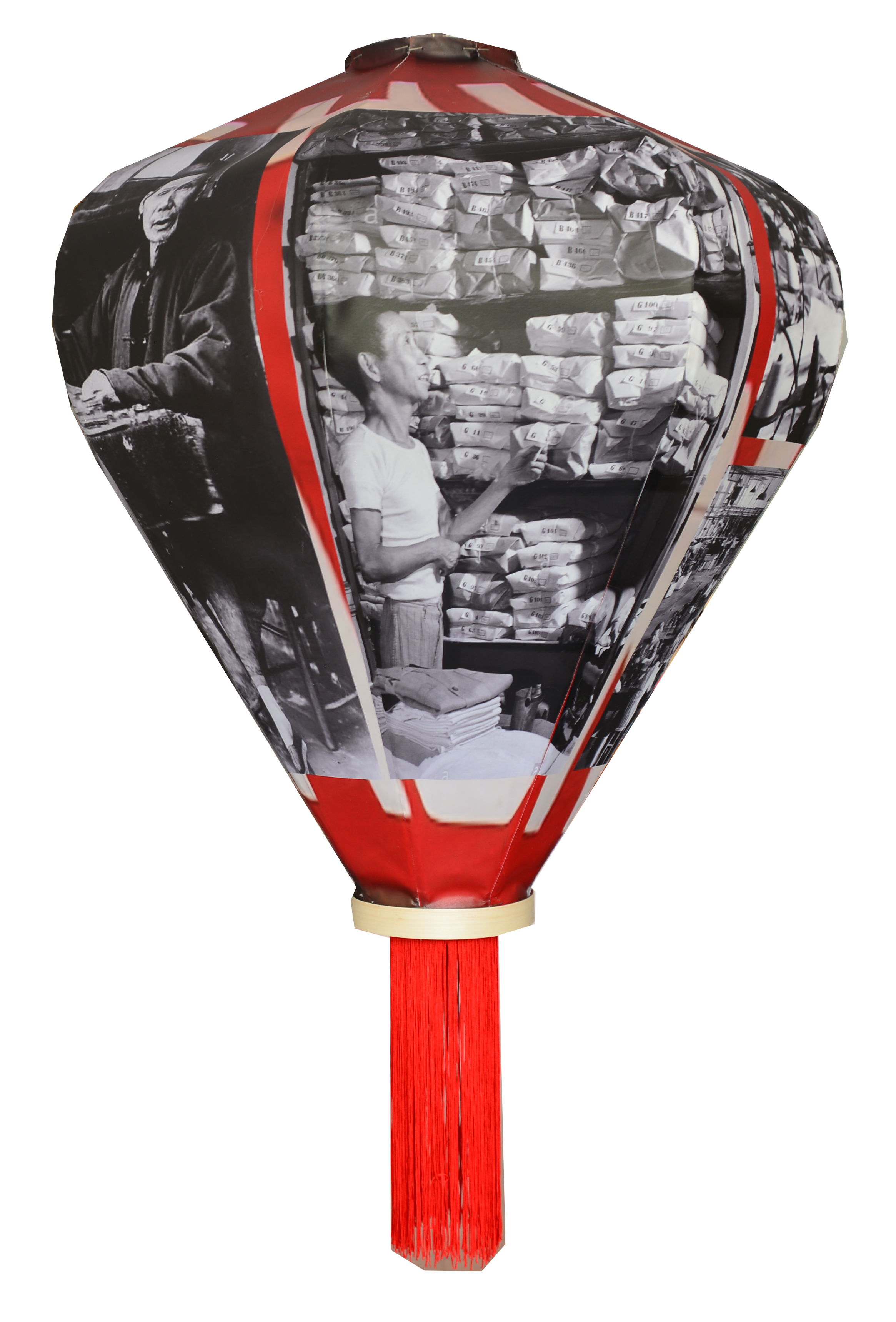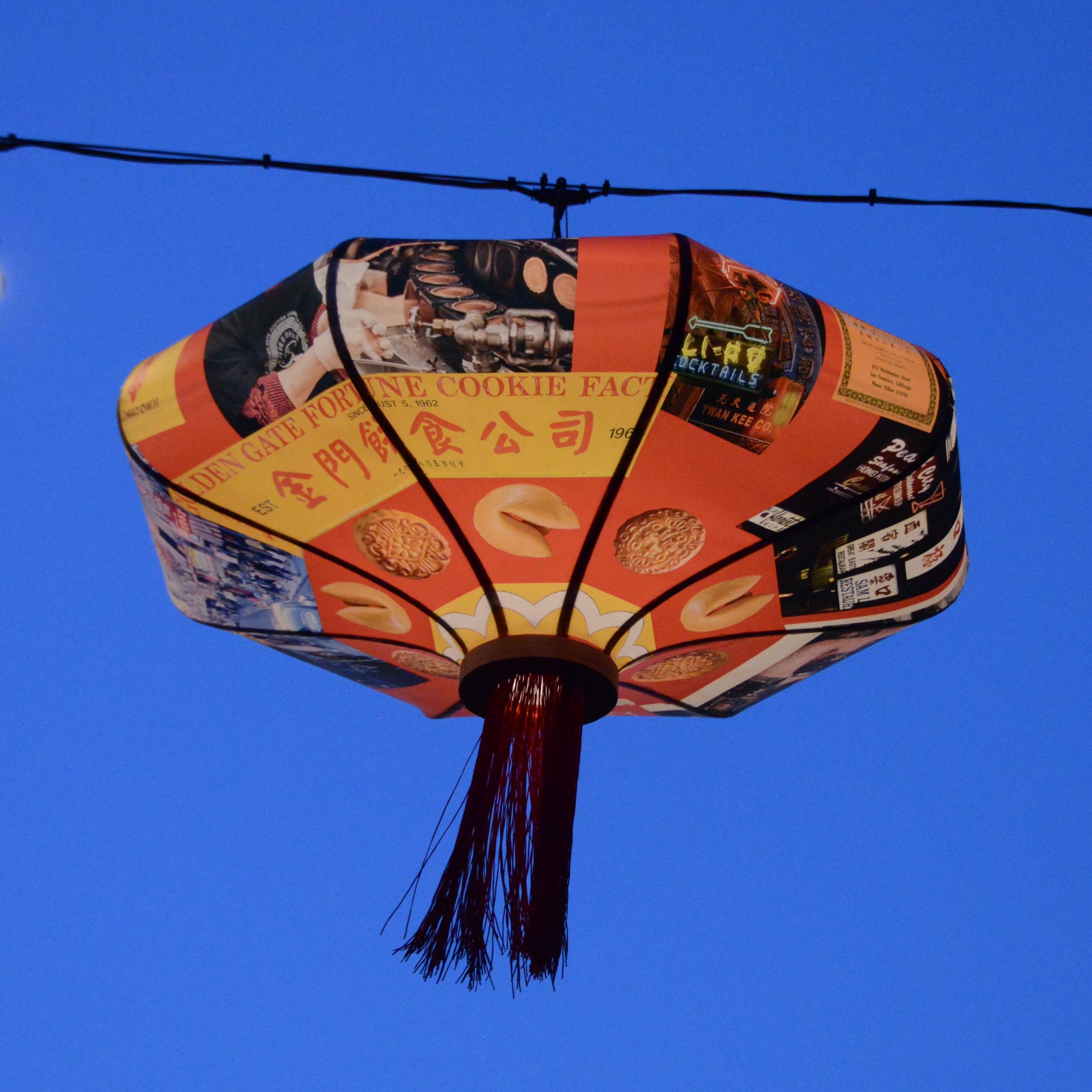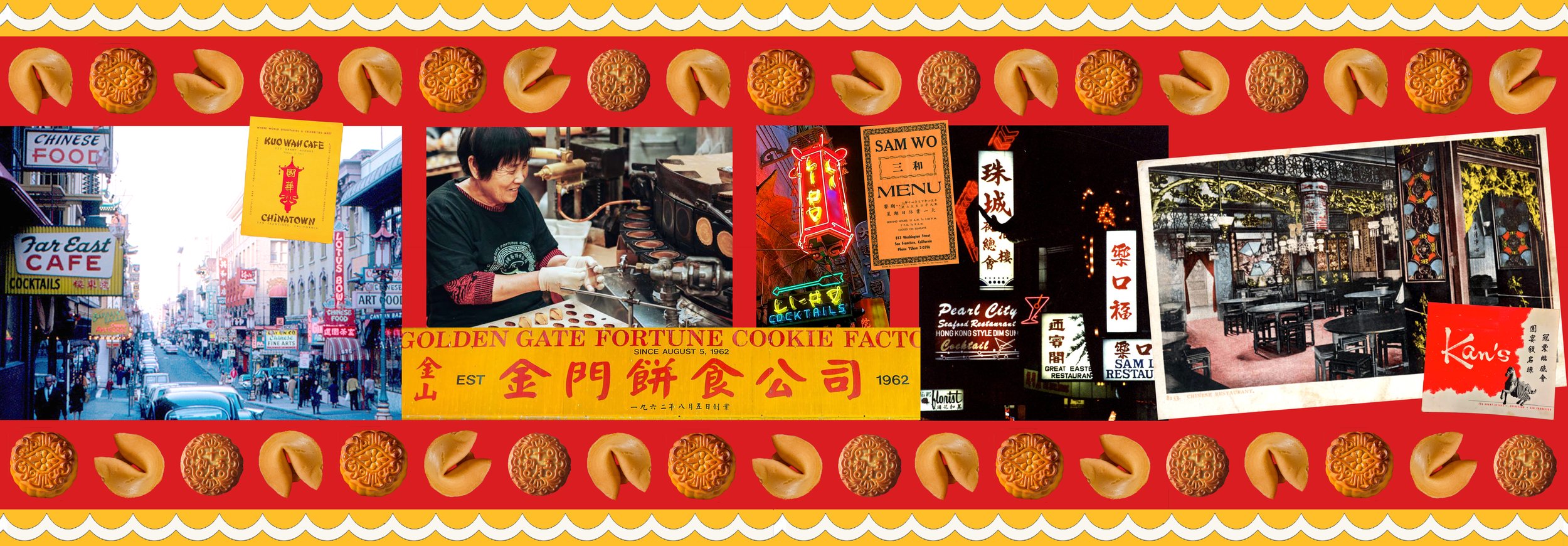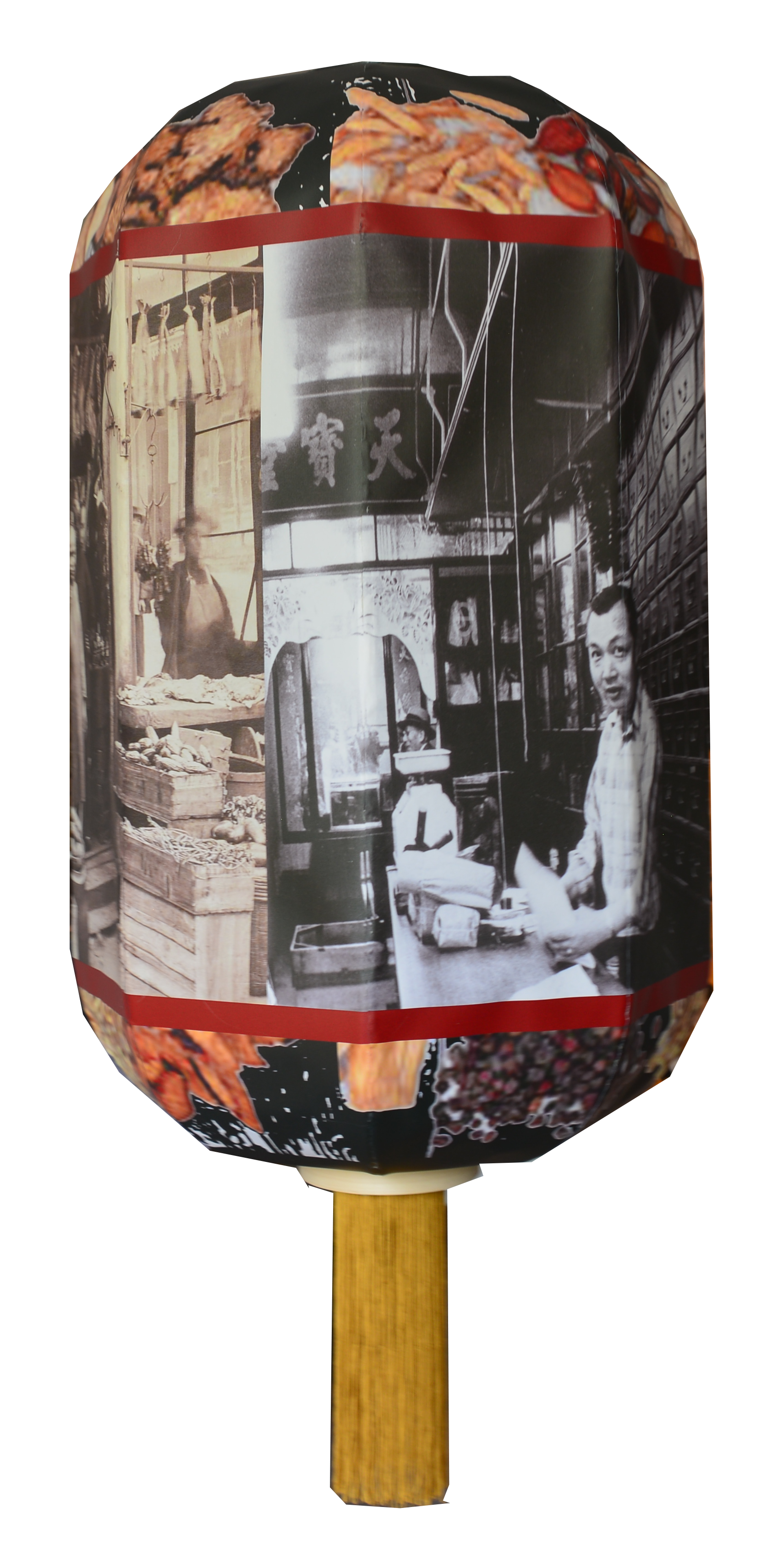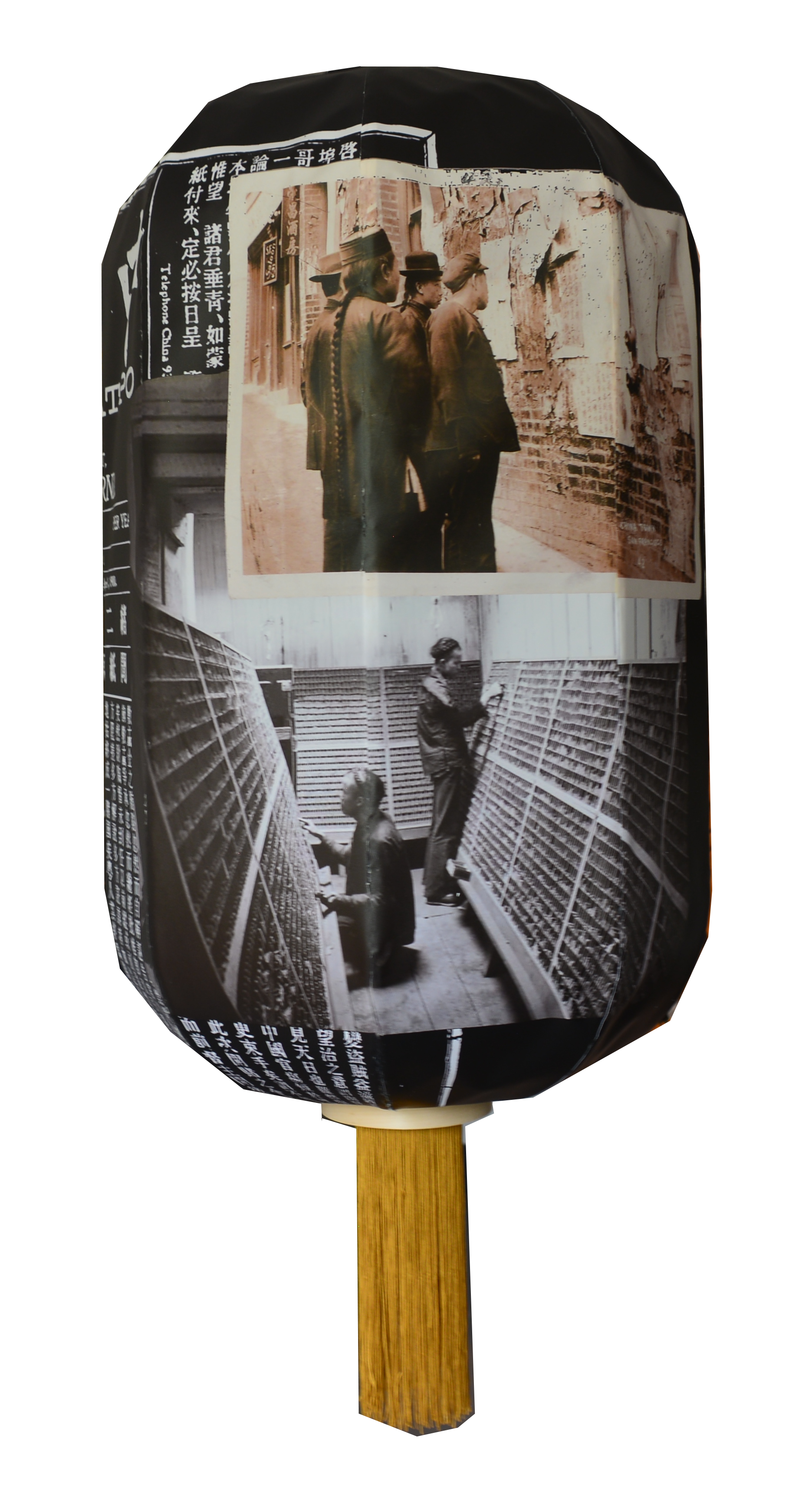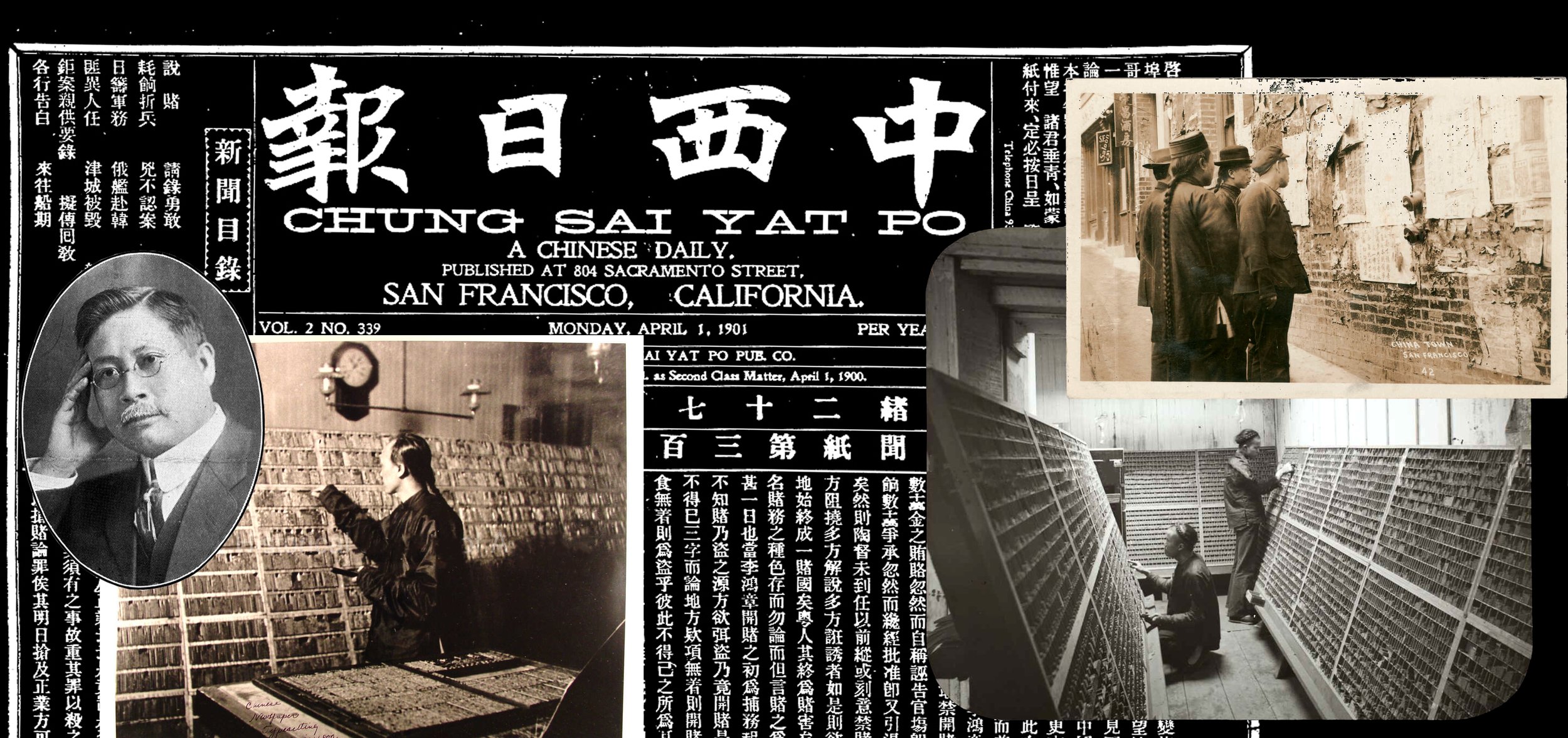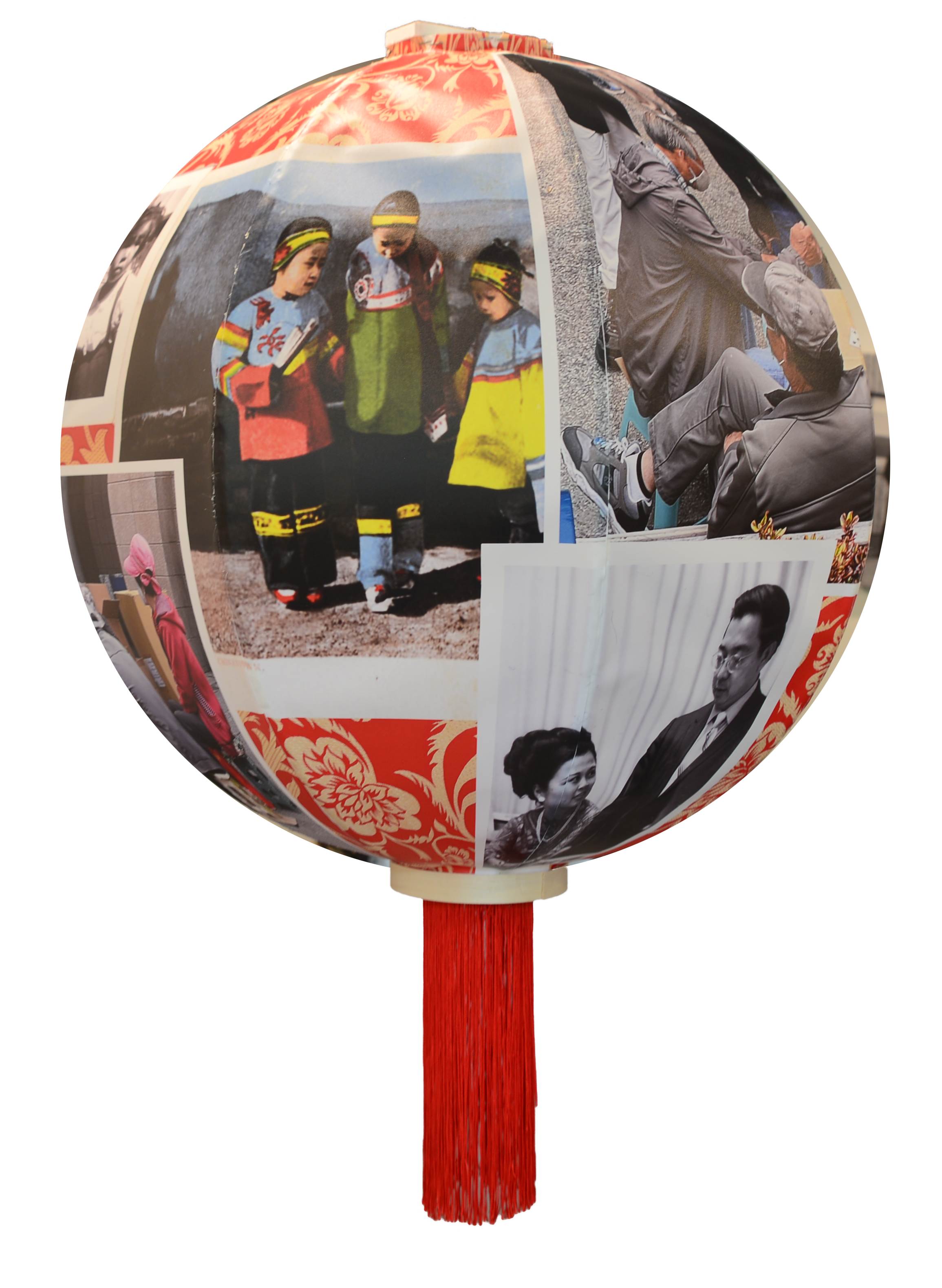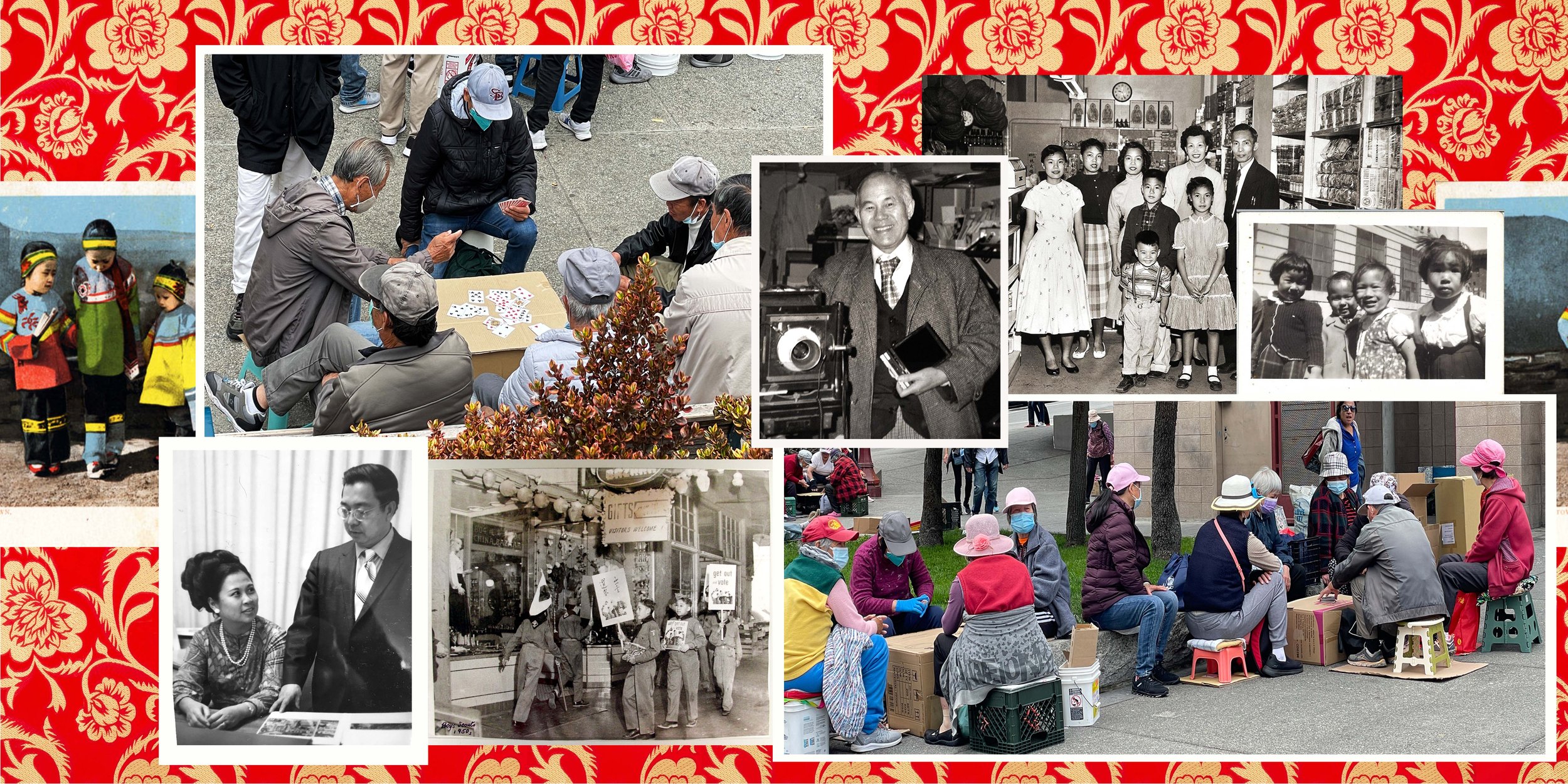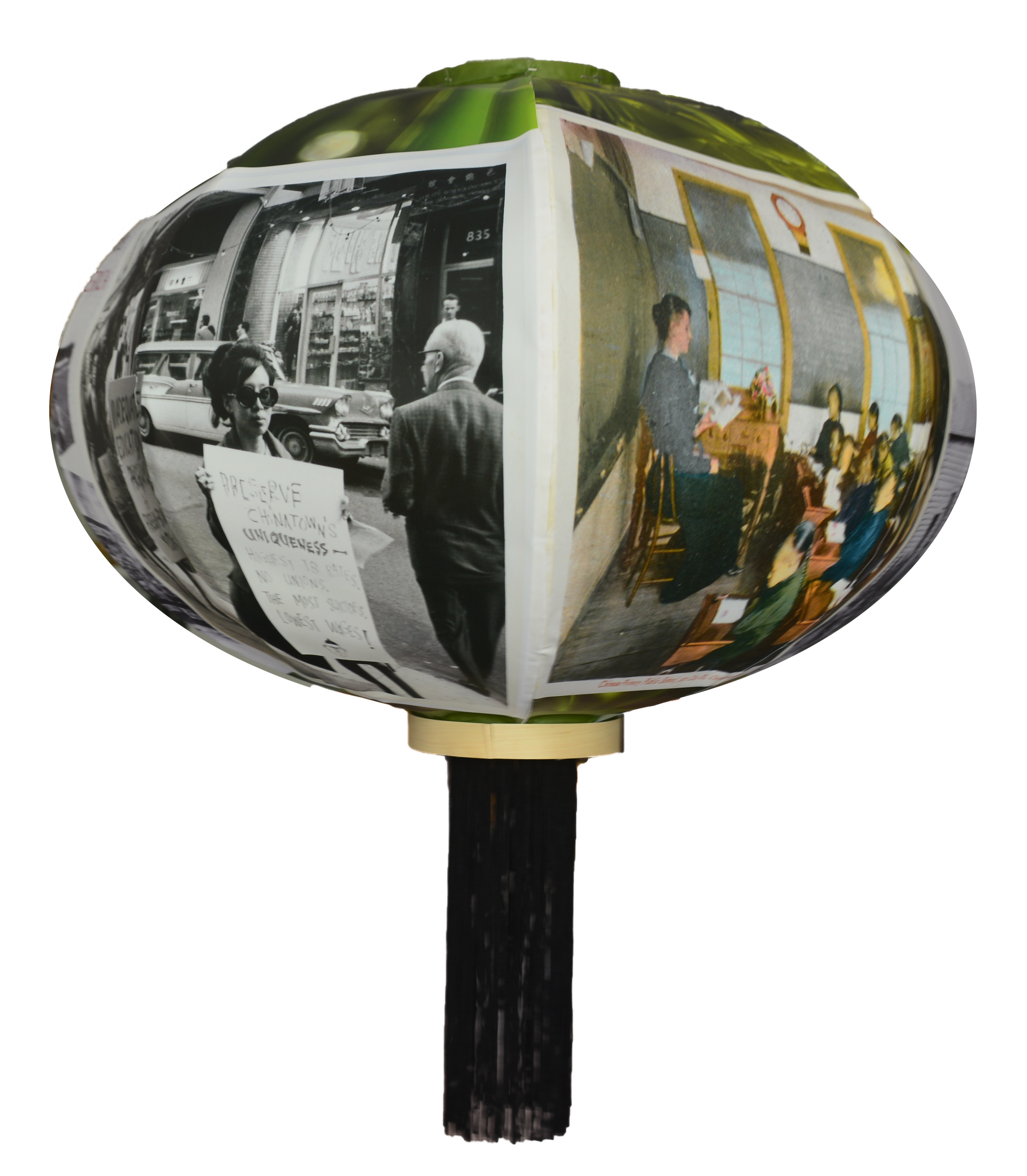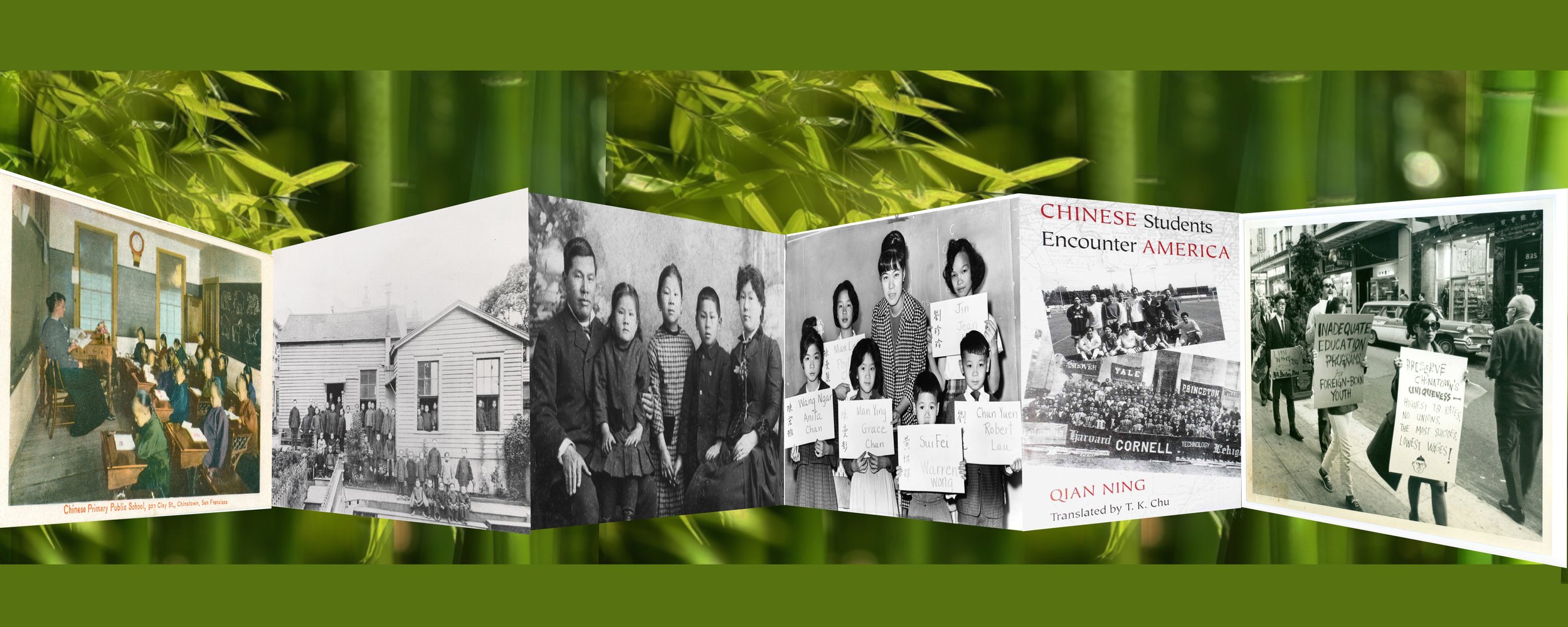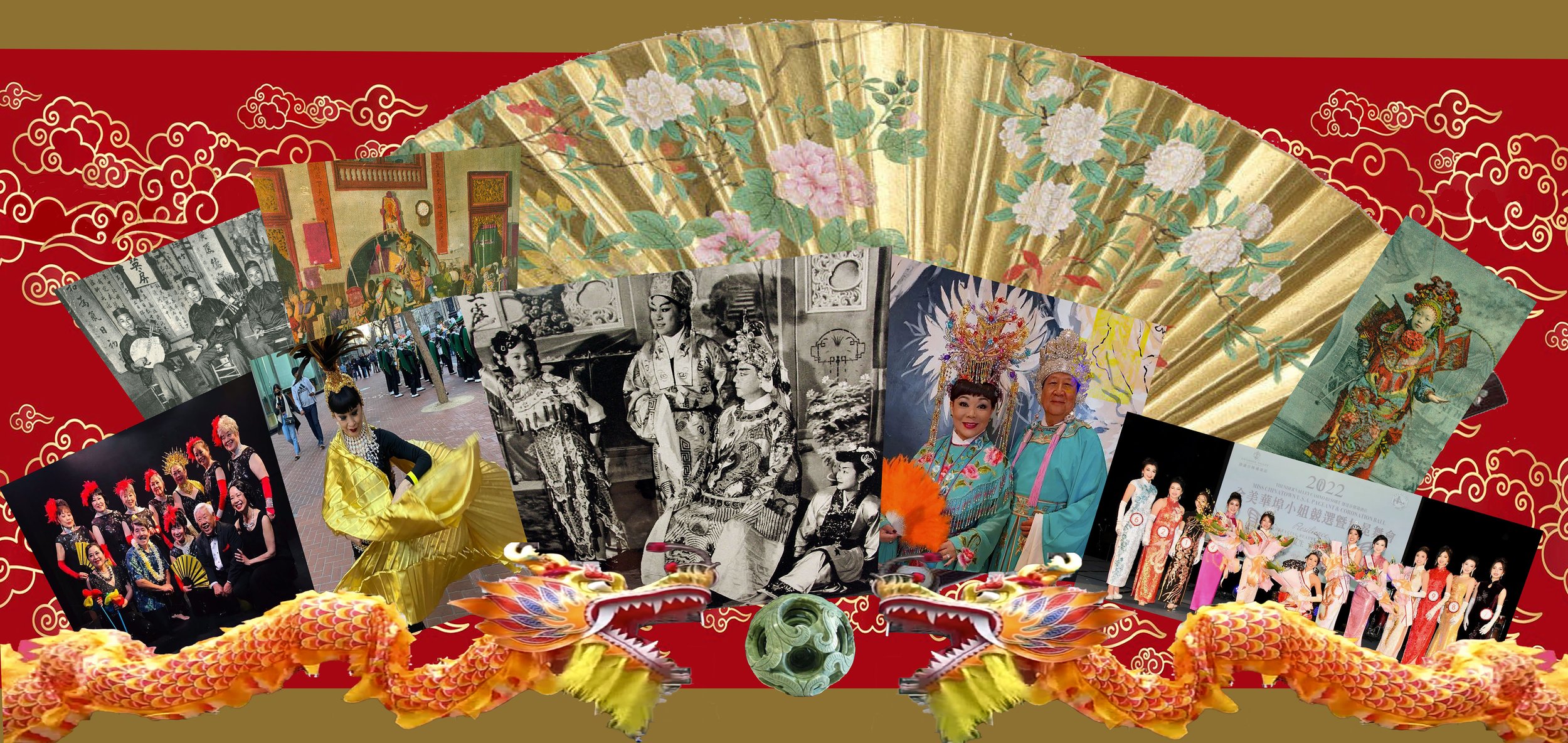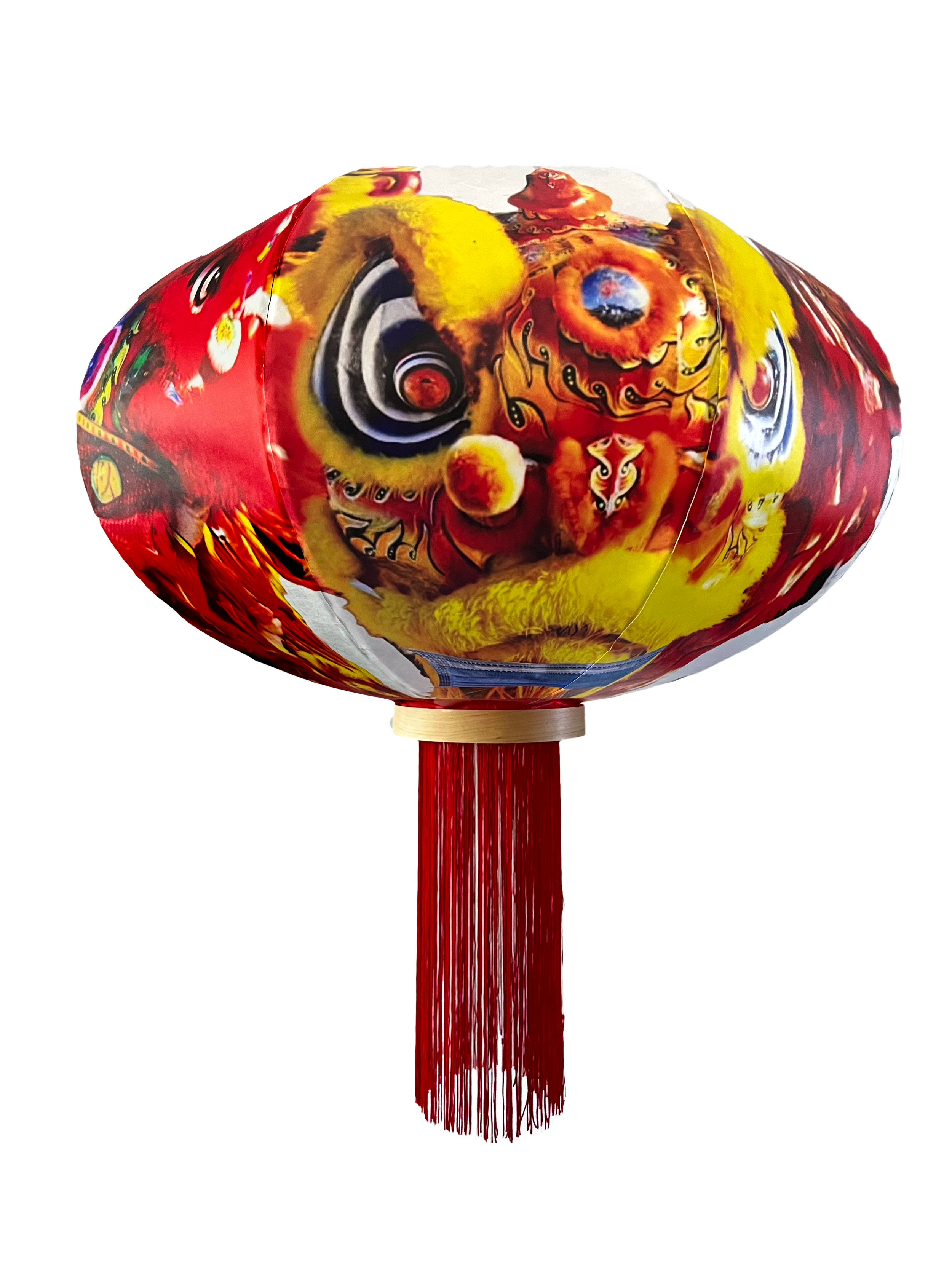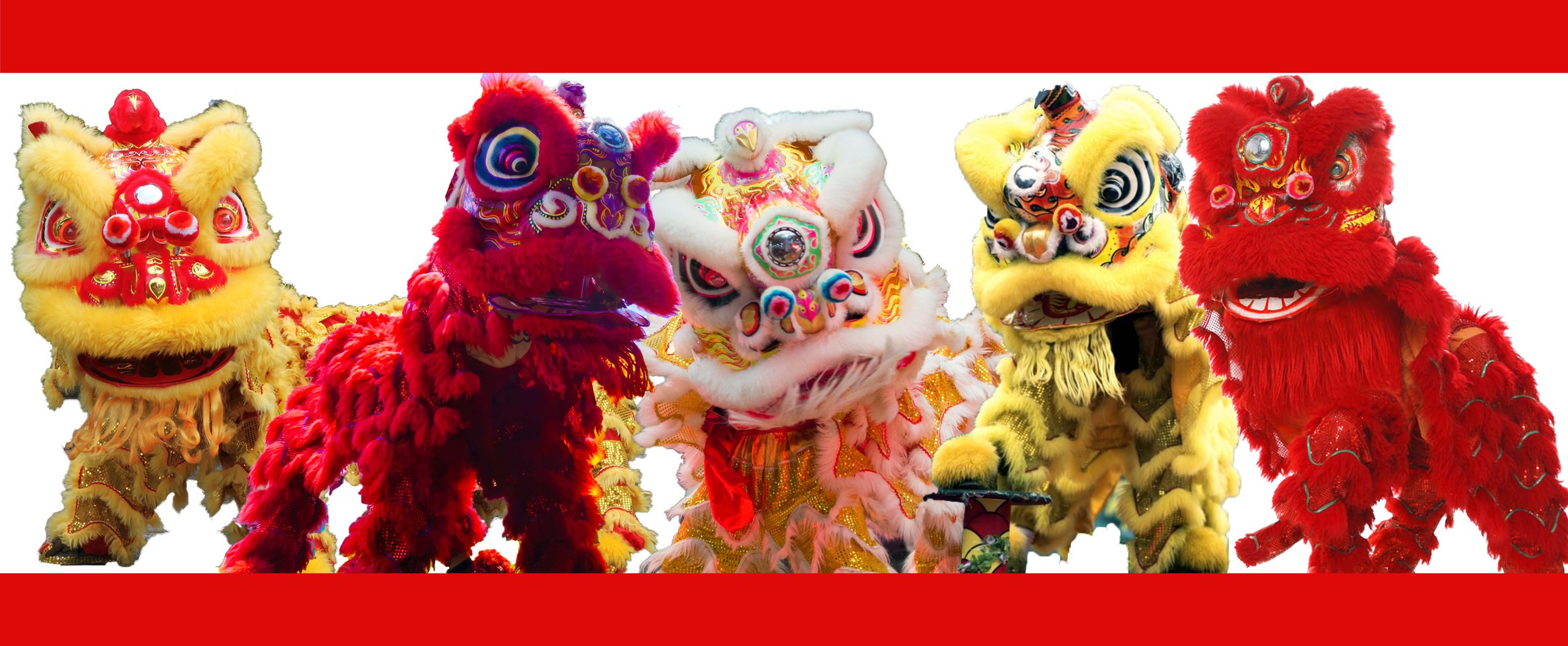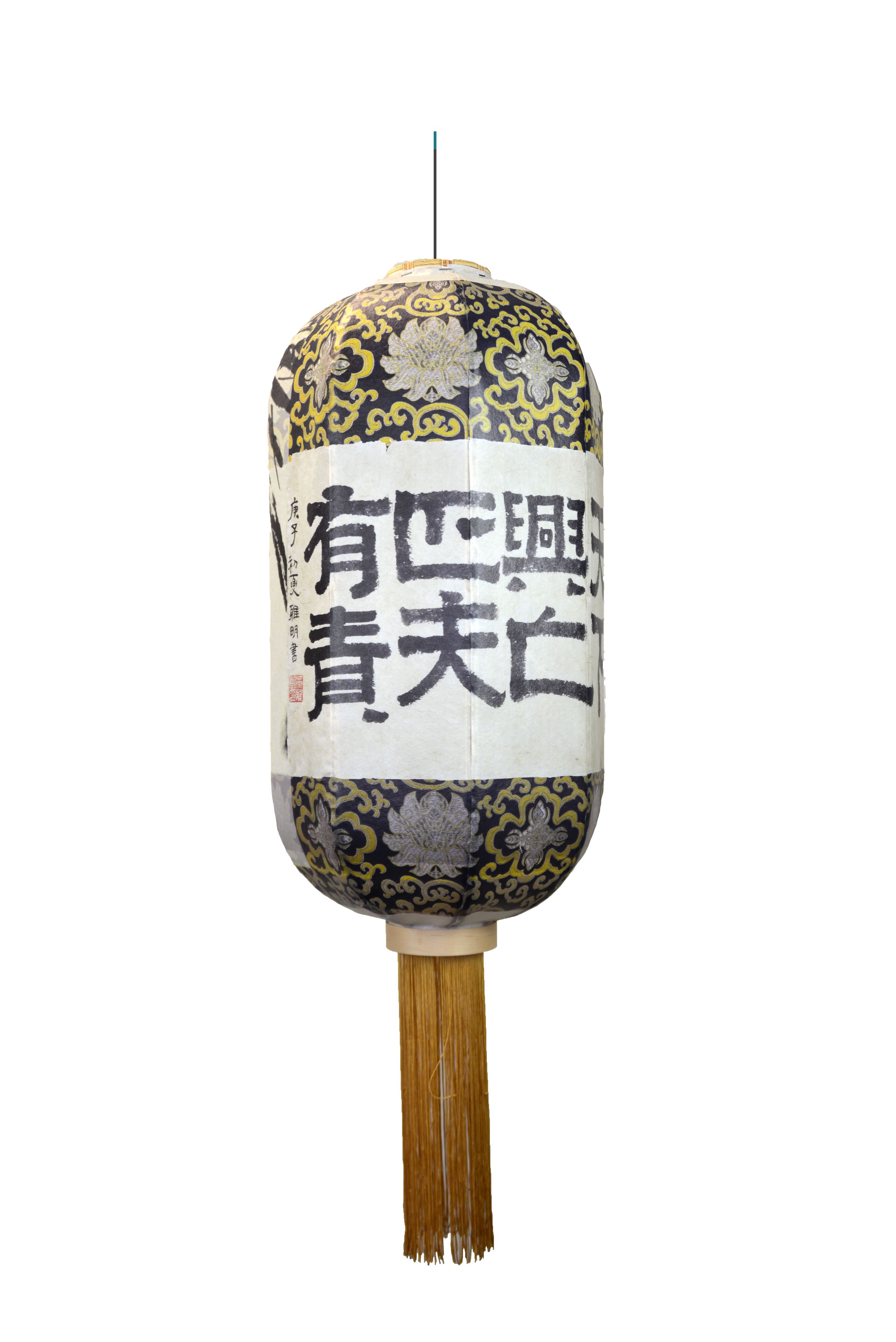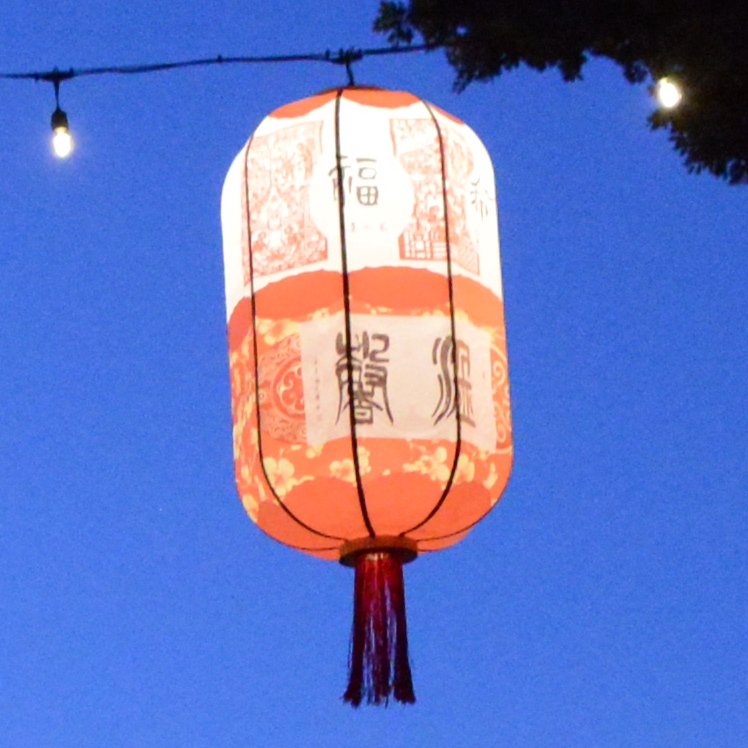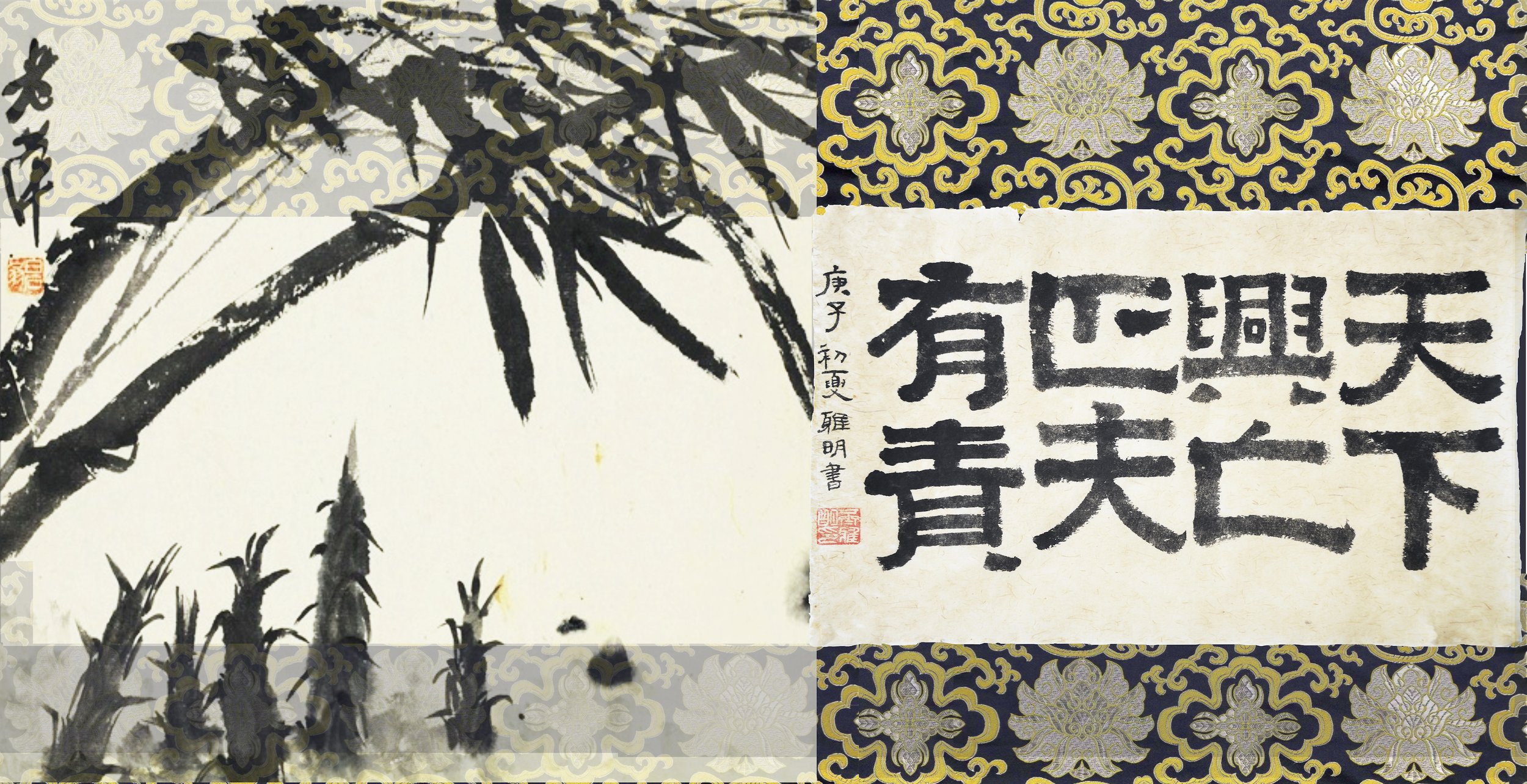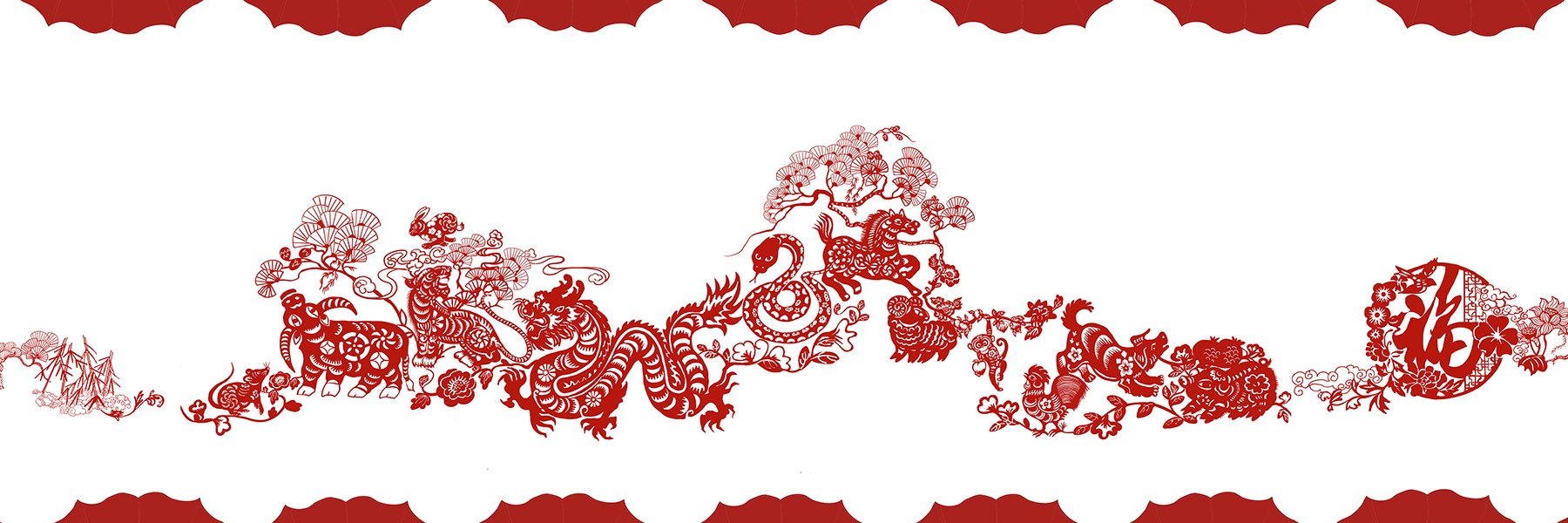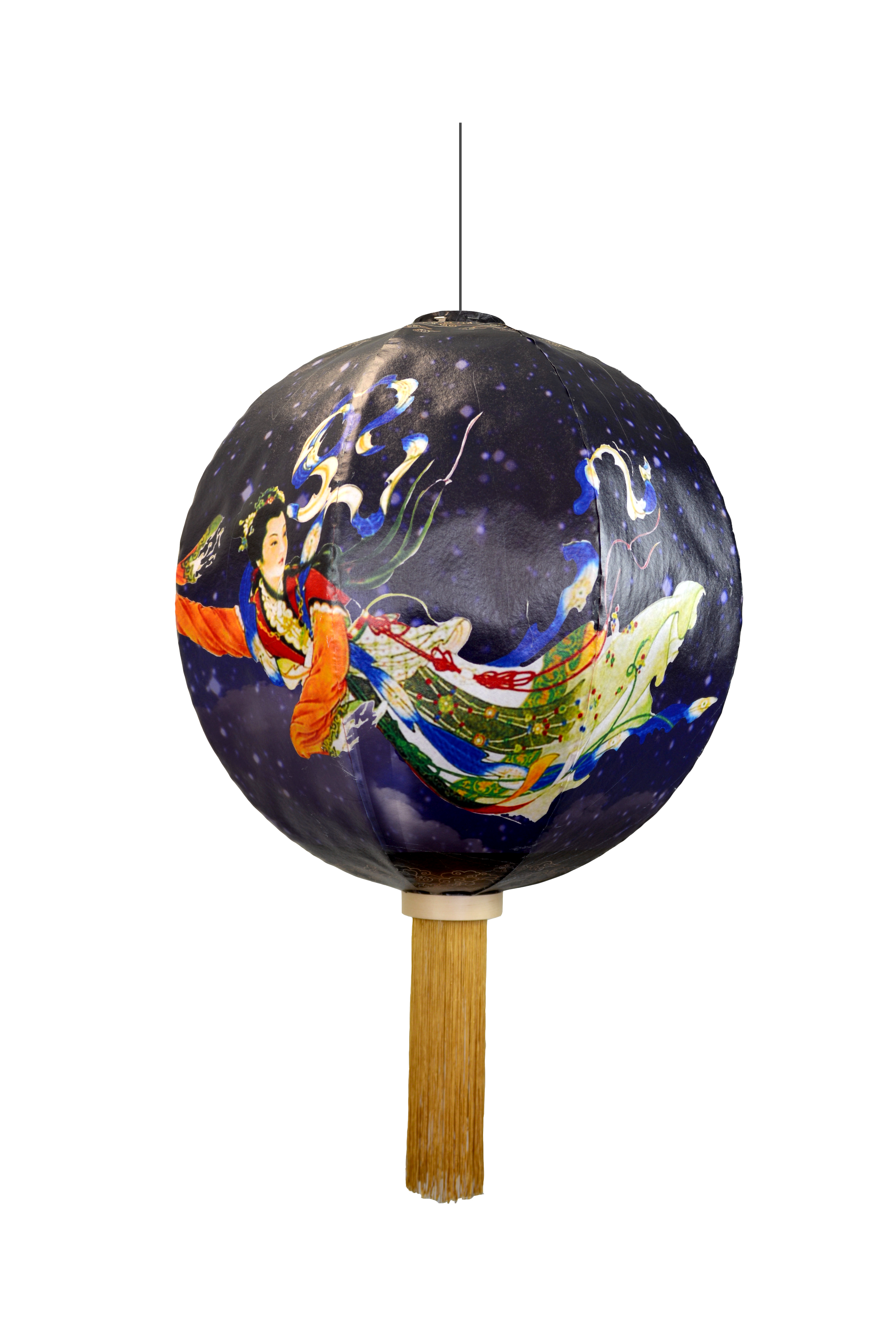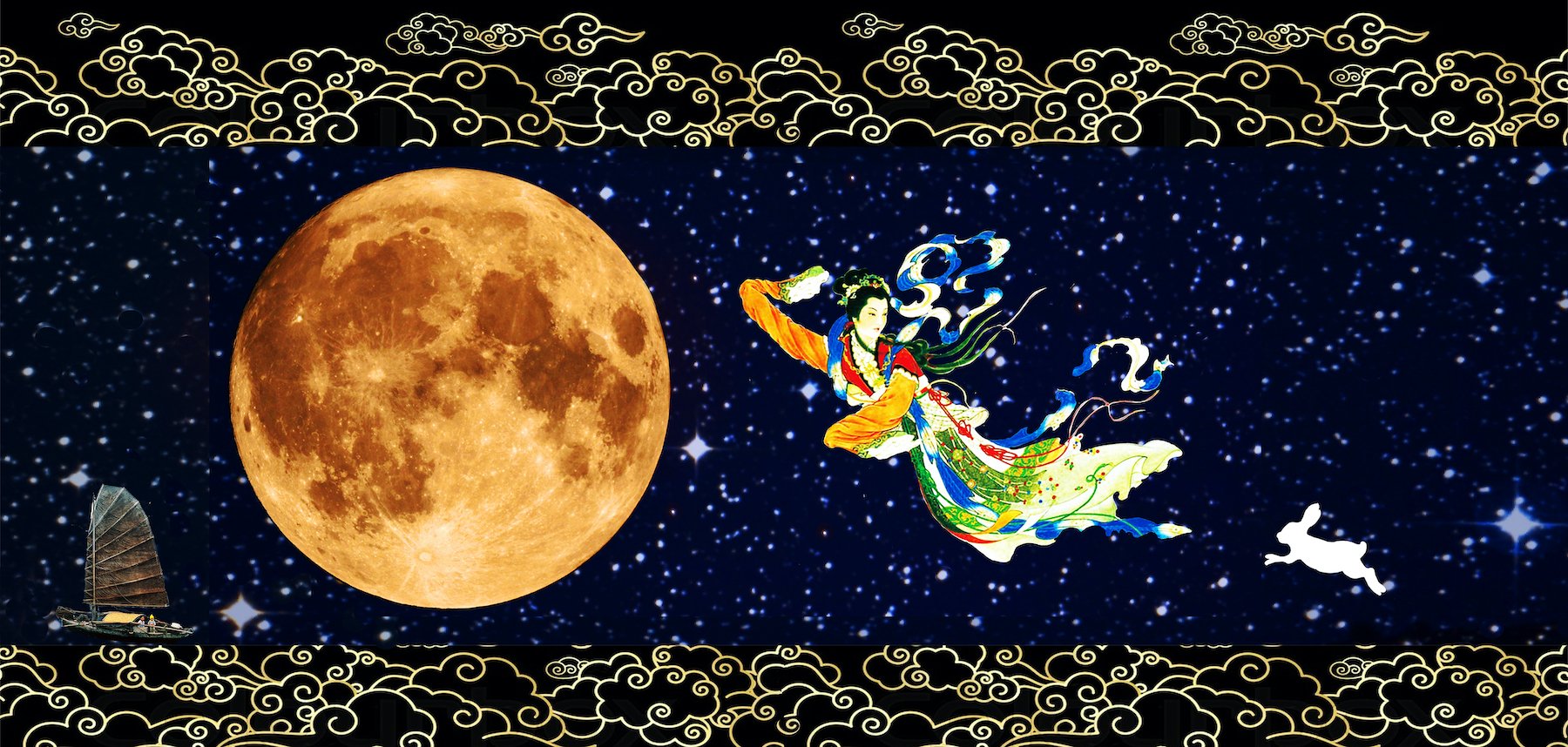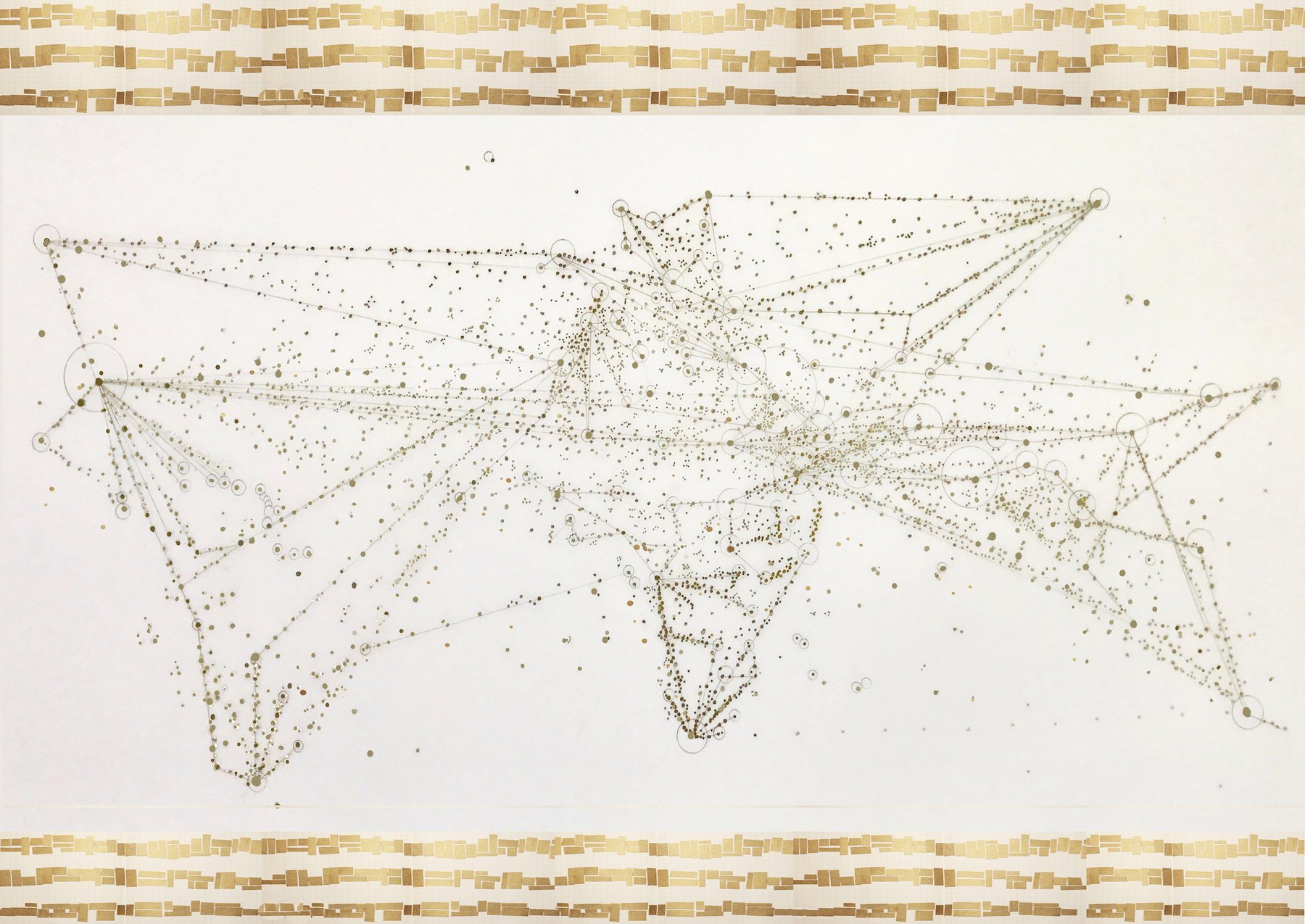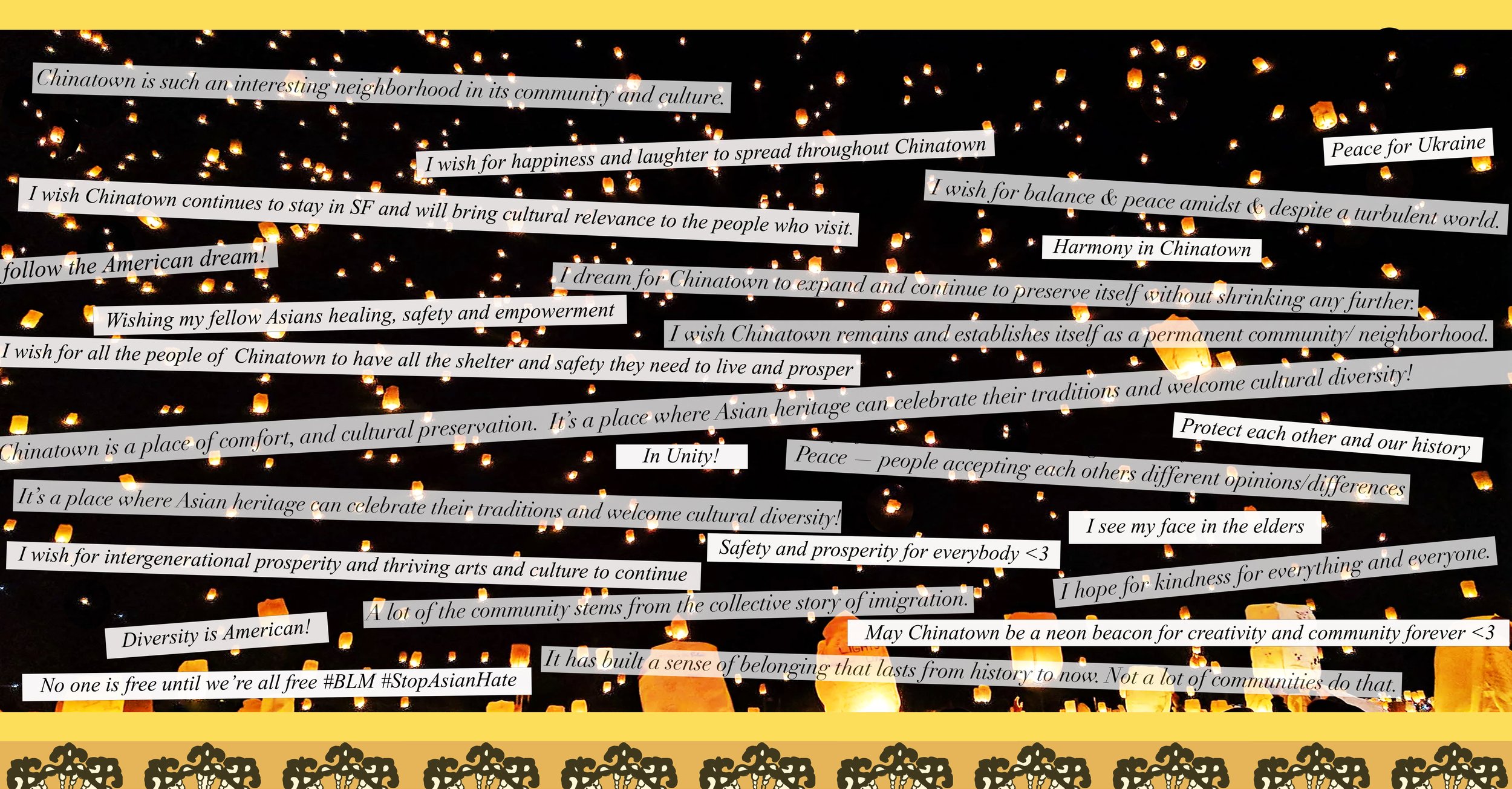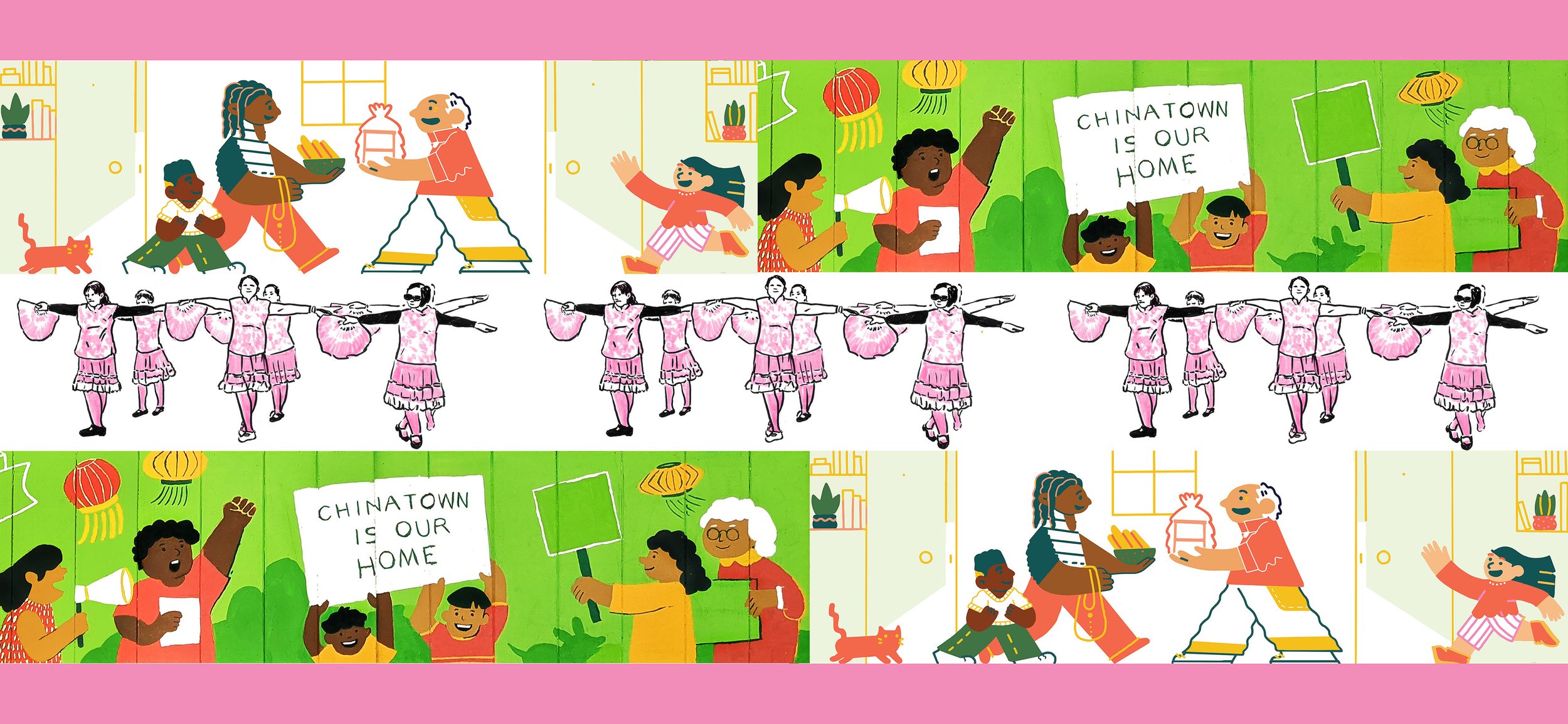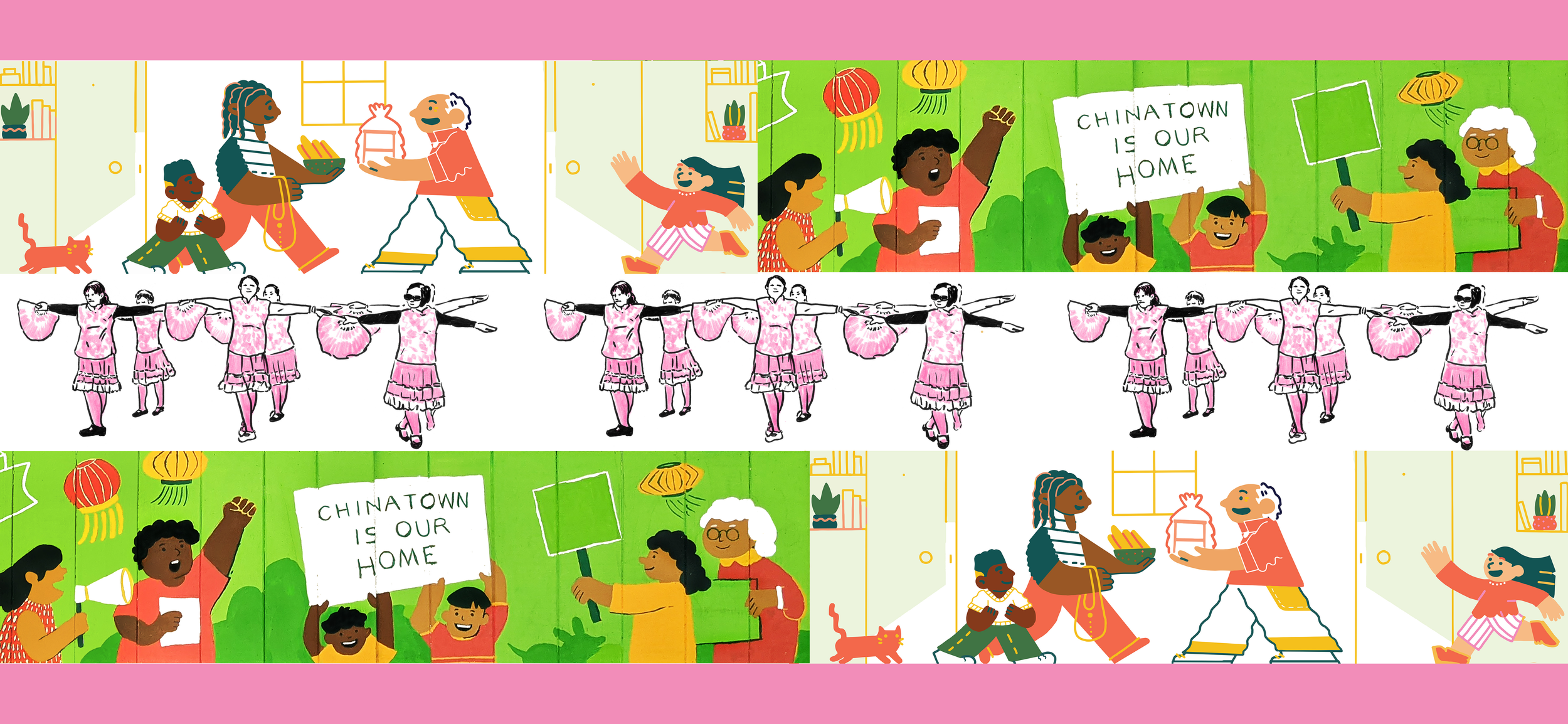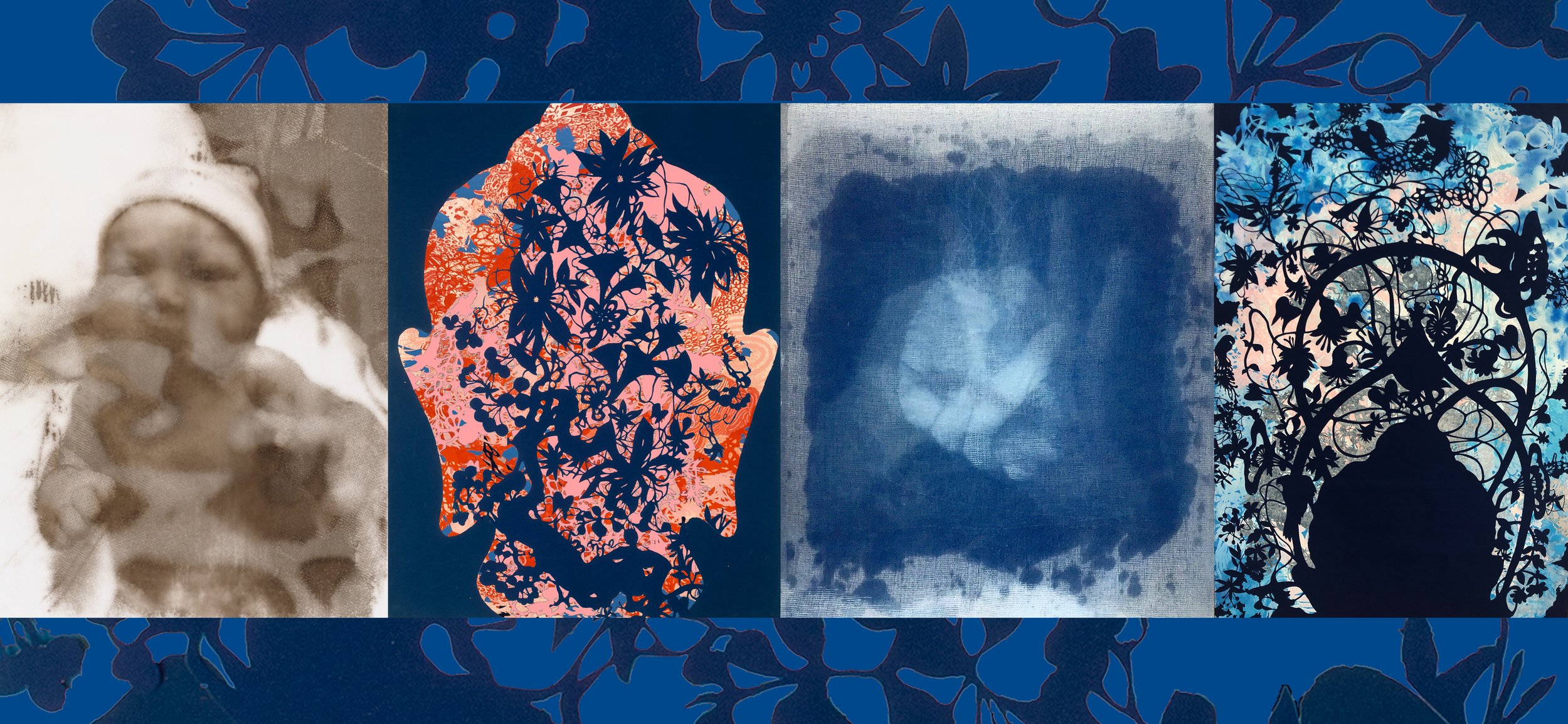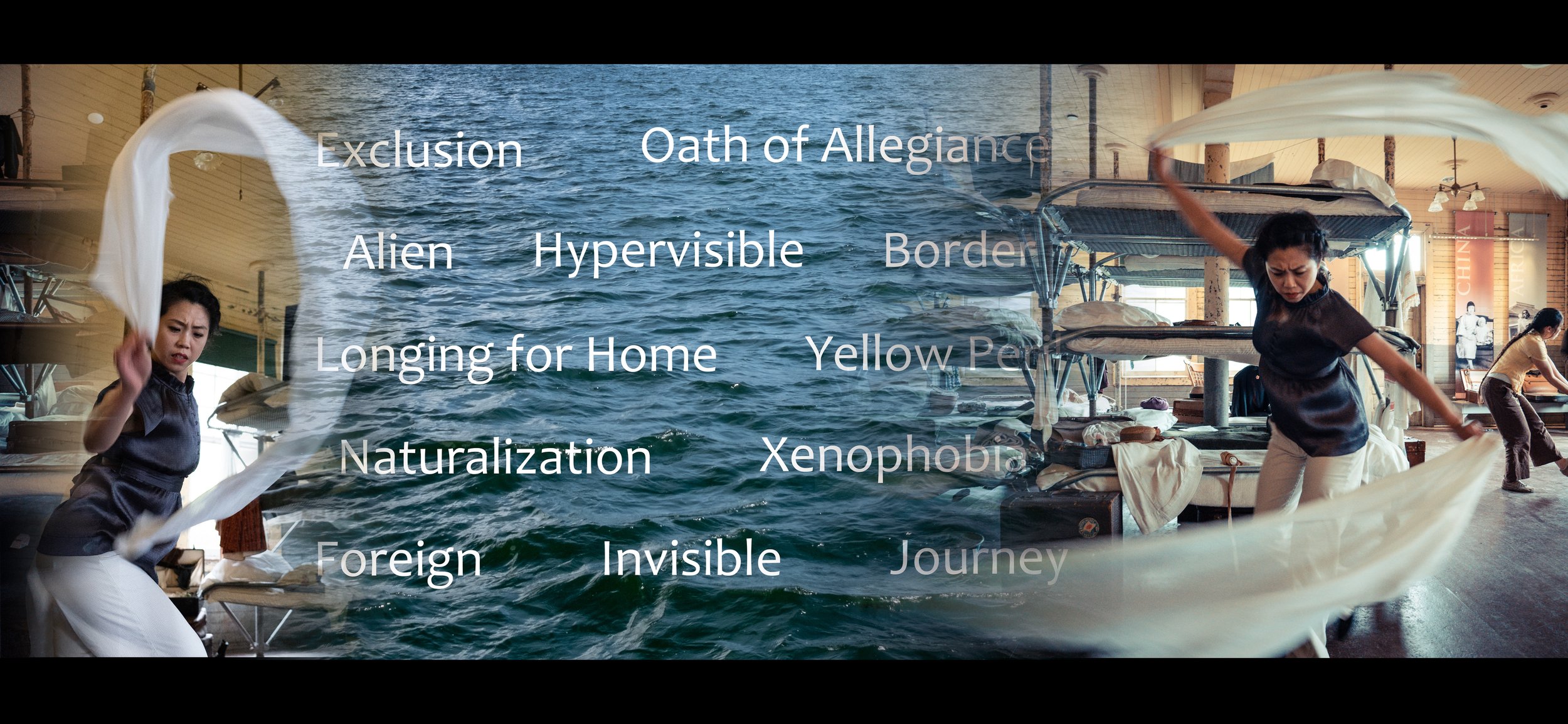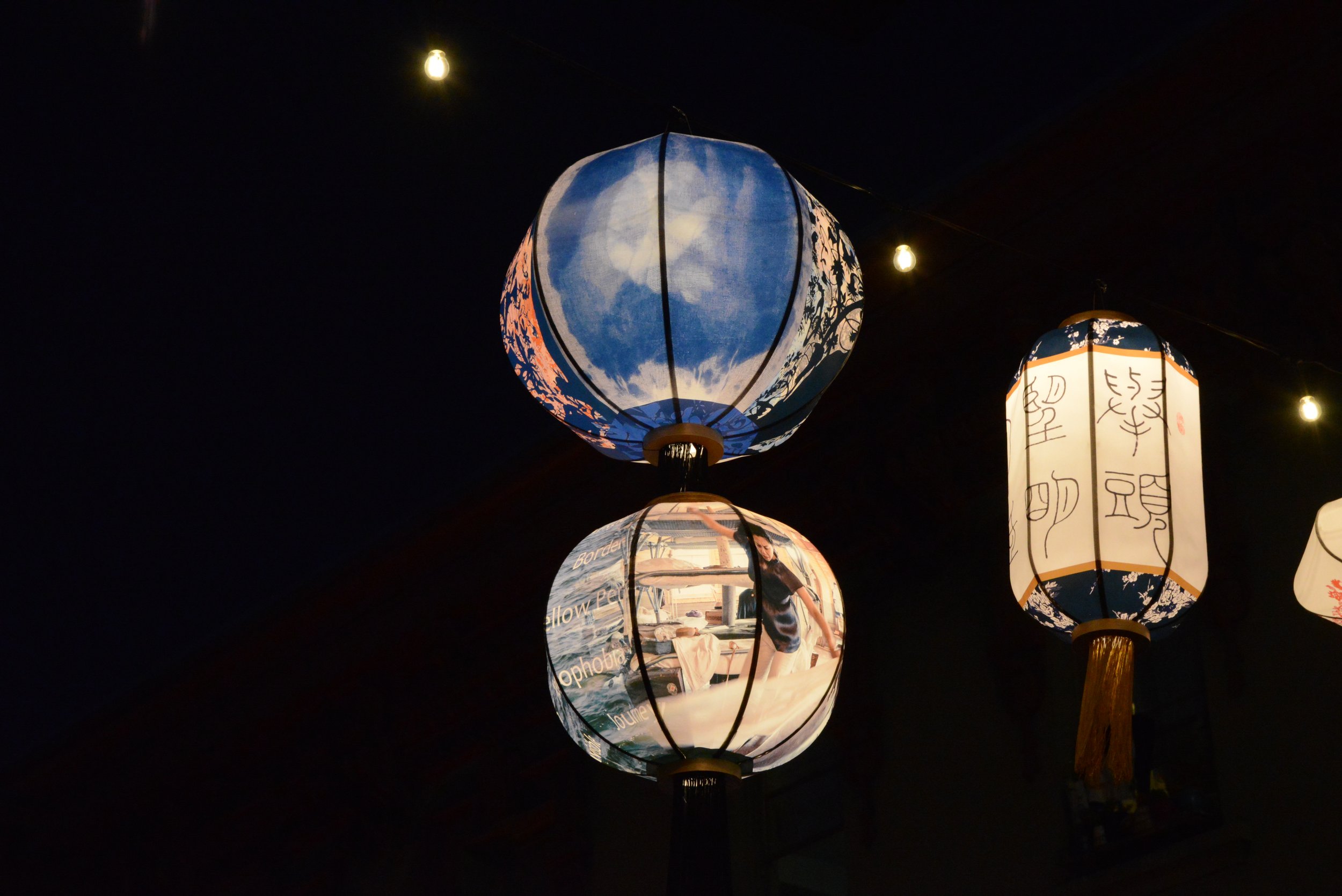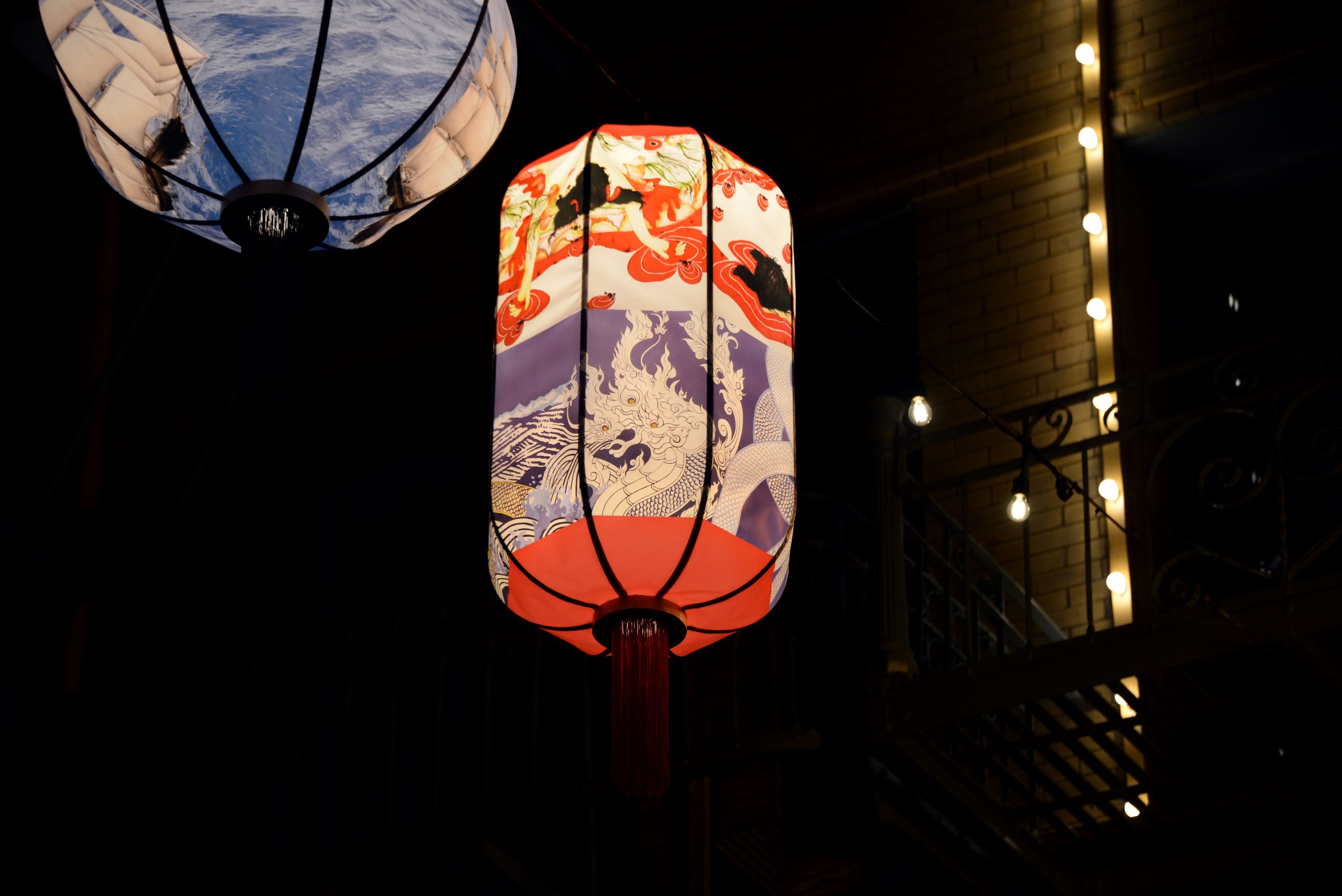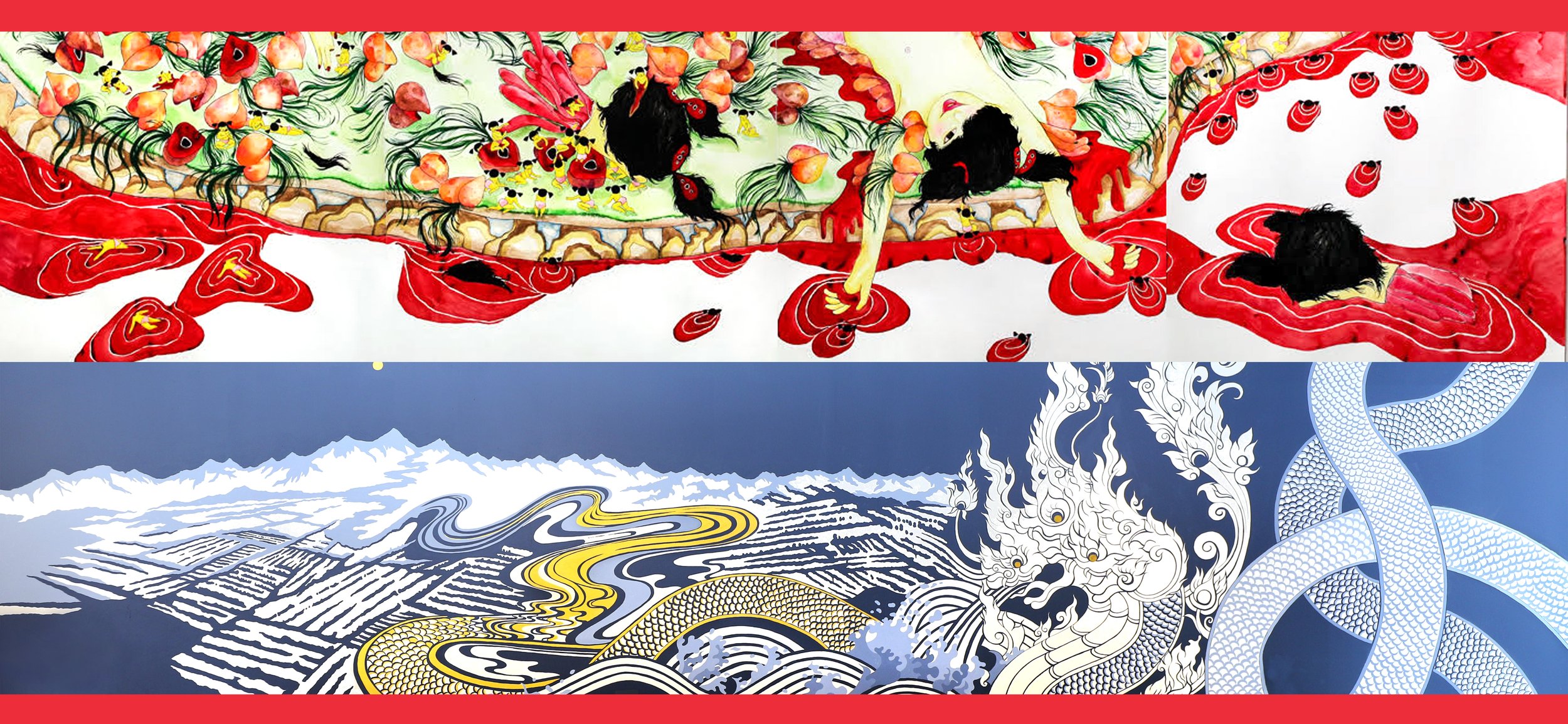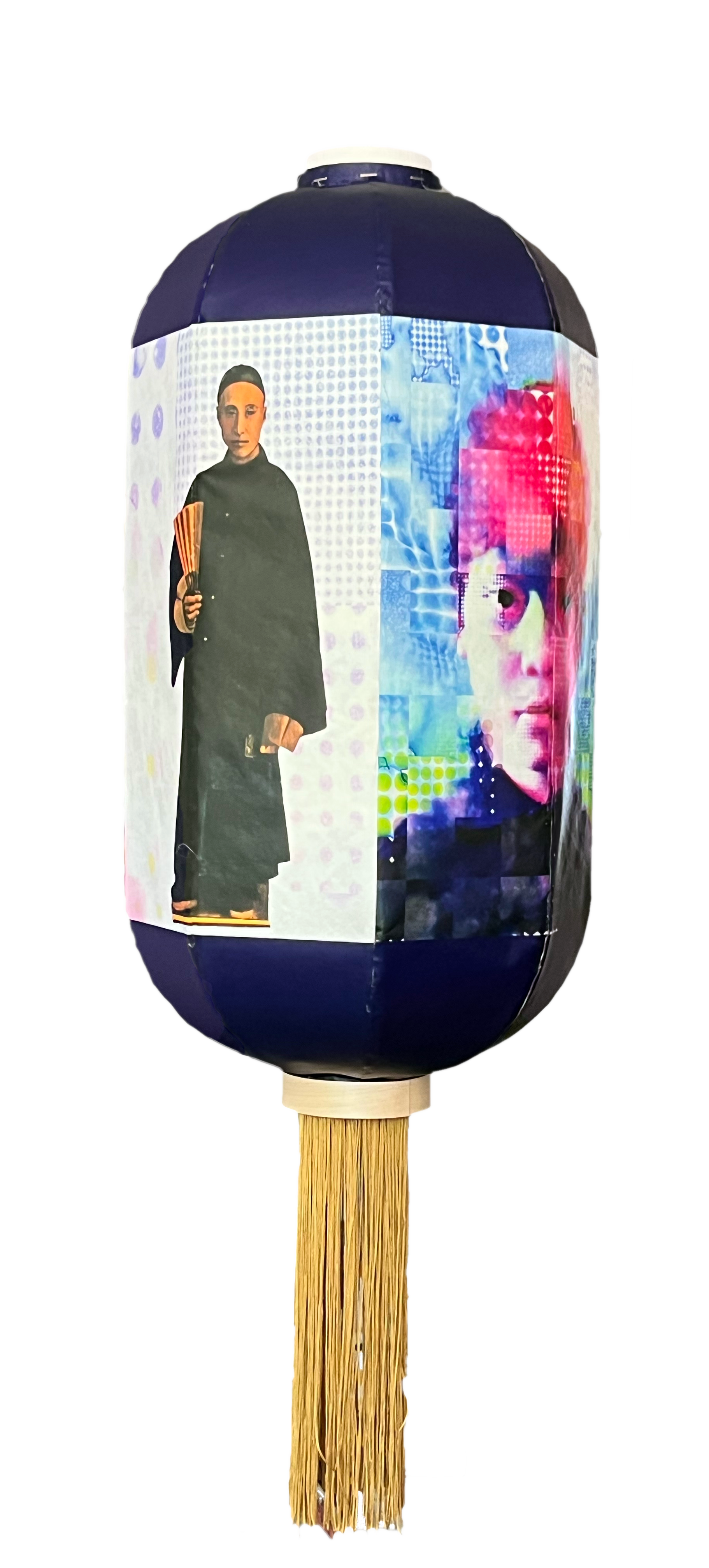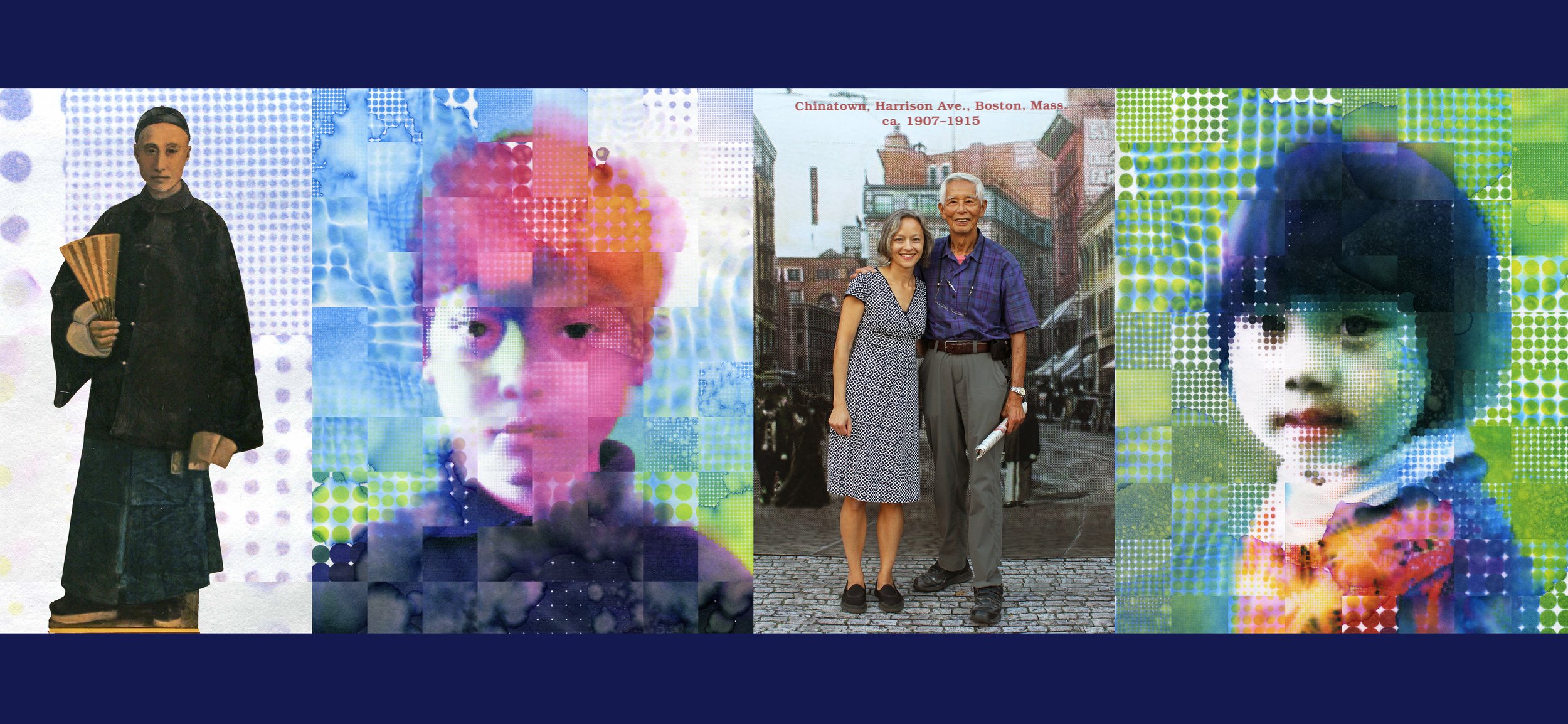Lantern Stories: San Francisco
LANTERNS BLOG
These 29 lanterns hold the experience and stories of the SF Chinatown community, past and present. They highlight the arts, calligraphy, music and performance, as well as the community’s strong commitment to education, entrepreneurship, and social justice. Explore the detailed images and stories of each lantern according to categories of History, Activism, Entrepreneurship, People (Life), and the Arts, including five lanterns featuring artwork by San Francisco and Boston-based artists.
這 29 盞燈籠承載著舊金山唐人街社區過去和現今的經歷和故事。 它們不但突出社區的藝術、書法、音樂和表演,還帶出社區對教育、創業和社會公義的堅定承諾。 請仔細探索每盞燈籠的圖像和故事。這些燈籠分為不同的主題——歷史、行動主義、企業家精神、居民生活和藝術。其中五盞燈籠包括了駐舊金山和波士頓藝術家的作品。
This project is made possible by the generous support of Robert J. Louie Memorial Fund.
HISTORY / 歷史
Arrival & Trade / 到達與貿易
Gold Rush & Transcontinental Railroad / 淘金熱和跨大陸鐵路
1882 Chinese Exclusion Act / 1882 年《排華法案》
Angel Island / 天使島
1885 Map & 1906 Earthquake / 1885 年地圖和 1906 年地震
Cameron House / 金馬倫樓
ACTIVISM / 行動主義
Stop Asian Hate / 停止反亞仇恨
ENTREPRENEURSHIP / 企業家精神
Entrepreneurship / 企業家精神
Restaurants / 飯店
Apothecary & Grocery / 藥劑師和雜貨店
Printing / 印刷
PEOPLE (LIFE) / 人物(生命)
San Francisco Notables / 舊金山名人
Family / 家庭
Education / 節日
Festival & Performance / 節日
Lions / 獅子
ARTS / 藝術
Calligraphy / 書法
Zodiac / 生肖
Moon Goddess / 月亮女神
Global Migration Map / 全球遷移地圖
Community Statements / 社區陳述
ARTIST LANTERNS
Yuko Okabe x Kathy Wu x Christine Wong Yap
Fred Liang x Lucy Kim x Summer Mei Ling Lee / Lenora Lee x Joanna Tam
Cathy Lu x Ponnapa Prakkamakul
Phillip Hua x Wen-ti Tsen
HISTORY / 歷史
Arrival & Trade / 到達與貿易
From the ancient Silk Road (est. first century BCE) to the first trade ships launched in 1405 exchanging goods between locations such as India, the Middle East and East Africa, China has long been a champion of foreign trade. The historical ship pictured here is Taeping, the clipper ship (a fast-speed merchant sailing vessel carrying cargoes of tea) which was victorious in the Great Tea Race of 1866 from China to London. It was the ship Pallas which arrived in Baltimore, MD in 1785 that carried the earliest documented Chinese immigrants to the United States. Afterwards, Chinese immigration saw mid-century fluxes with the advent of the California Gold Rush in 1848 and with the passage of the Burlingame Treaty in 1868, which permitted Chinese and Europeans alike to immigrate between their countries of origin. As a result, an estimated 322,000 Chinese laborers arrived between 1850-1882.
從古老的絲綢之路(建於公元前一世紀)到1405年首艘貿易船與印度、中東和東非等地交易貨物,中國一直是對外貿易的大國。圖中的歷史船隻是Taeping號。它是一艘飛剪船(一種載有茶葉的快速商船),在1866年中國到倫敦的大茶賽中取得了勝利。Pallas號於1785年抵達馬里蘭州的巴爾的摩,該船載有最早有記錄的中國移民到美國。此後,中國移民見證了世紀中期的變化。1848年加利福尼亞淘金熱的到來以及1868年《蒲安臣条约》的簽訂使中國人和歐洲人一樣可以移民。這致使約322,000名中國工人在1850-1882年之間到達美國。
Gold Rush & Transcontinental Railroad / 淘金熱和橫貫大陸鐵路
These images center on Chinese miners who are shown carrying yokes, rockers, pickaxes, and shovels. These solitary sojourners were the first people of China to immigrate to the United States in large numbers during the California Gold Rush (1848-1855) amid China’s economic and political instability at the time, but were met with much hostility upon arrival. They entered California through the port of San Francisco, earning the city the nickname “Gold Mountain” as it became the central metropolis of California during the Gold Rush. Those who stayed after the Gold Rush were hired to work on the Pacific portion of the Transcontinental Railroad (see map). The railroad’s construction would not have been completed in 1869 if it were not for the labor of an estimated 20,000 Chinese workers, who toiled tirelessly in dangerous conditions for five years, yet made 30-50% lower wages than white railroad workers. Pictured in the color photo are the descendants of Chinese immigrant railroad workers, who gathered for the railroad’s 150th anniversary in 2019 to recognize their ancestors’ labor.
這些黑白照片拍攝了當時的華人礦工。他們攜帶著軛、搖桿、鎬和鐵鍬。 在1848-1855 期間,大批華人因當時中國經濟和政治不穩和受加州淘金熱潮的吸引,選擇獨自前往美國。 可是,他們抵達後卻受到極大的敵意。 他們由舊金山港口進入加州。「金山」的稱號並源於當時淘金熱潮令舊金山成為加州的中央大都會。在淘金熱潮過後,留下來的華人礦工被雇用於興建跨美國大陸鐵路的太平洋部分(見地圖)。 在 1869 年,幸好有大概二萬名華人鐵路勞工的苦勞,這條跨大陸鐵路才能完成。這些勞工在極度危險的環境下工作了五年,但他們的工資卻比白人鐵路勞工的低三至五成。這些近照拍攝於2019年鐵路開通150週年。一群華人鐵路勞工的後代一起紀念他們祖先的工勞。

The 1882 Chinese Exclusion Act / 1882年《排華法案》
Amid the 1850s Gold Rush and a scarce job market in the 1870s, American settlers felt threatened by the incoming Chinese labor force, and the U.S. made many legislative attempts to prevent their settlement. Most famously, the 1882 Chinese Exclusion Act indefinitely banned immigration from China. To this day, it is the only U.S. law ever implemented to ban the immigration and naturalization of a specific ethnic/national group. The Exclusion Act was finally repealed in 1943, reopening limited immigration and permitting new Chinese settlers to apply for citizenship. Such systematic acts of racism, coupled with personal and daily struggles with sinophobia, drove Chinese Americans to build their own “ethnic enclaves,” or Chinatowns, across the country.
Pictured in the central portrait is Wong Kim Ark, a young Chinese-American man born in San Francisco. When he visited family in China and was denied re-entry into the U.S. upon his return, he took on the Supreme Court in what would become the landmark 1898 case United States v. Wong Kim Ark. The outcome of this case cemented birthright citizenship for the children of legal immigrants.
Inspired by the 1960s civil rights movement, the 1965 Immigration and Nationality Act was passed in order to discourage discrimination against Asian immigration, reunite immigrant families, and attract skilled labor to the United States. This Act would have a significant impact on the future demographic makeup of the American population, which prior to the act’s passage was monitored by ethnic quotas enforced by the National Origins Formula.
在1850年的淘金熱和工作稀缺的就業市場中,美國定居者感到即將到來的中國勞動力的威脅,並進行了許多嘗試來阻止他們的定居。最著名的是,1882年的《排華法案》無限期禁止中國移民。時至今日,這是美國唯一實施過的禁止特定種族/國籍移民的法律。該法於1943年廢除,重新開放了移民並允許中國定居者申請公民身份。這種系統性的種族主義行為,再加上與反華者的個人和日常鬥爭,驅使華裔美國人在全國范圍內建立自己的“民族飛地”或唐人街。
在照片中央的這位是黃金德,一位出生於三藩市的年輕華裔男子。因為一次到中國探親後返美時被美國拒絕入境的緣故,他便上訴挑戰美國最高法院。這個事件就成為了歷史性的1898年美國訴黃金德案。這個案件的判決鞏固了合法移民的子女的出生公民權。
受20世紀60年代民權運動的啟發,1965年《移民和國籍法》通過,目的是阻止對亞洲移民的歧視,使移民家庭團聚並吸引技術工人到美國。該法案對美國人口的未來構成產生重大影響。此法案通過之前,人口受《国家起源法案》強制執行的種族配額所監控。
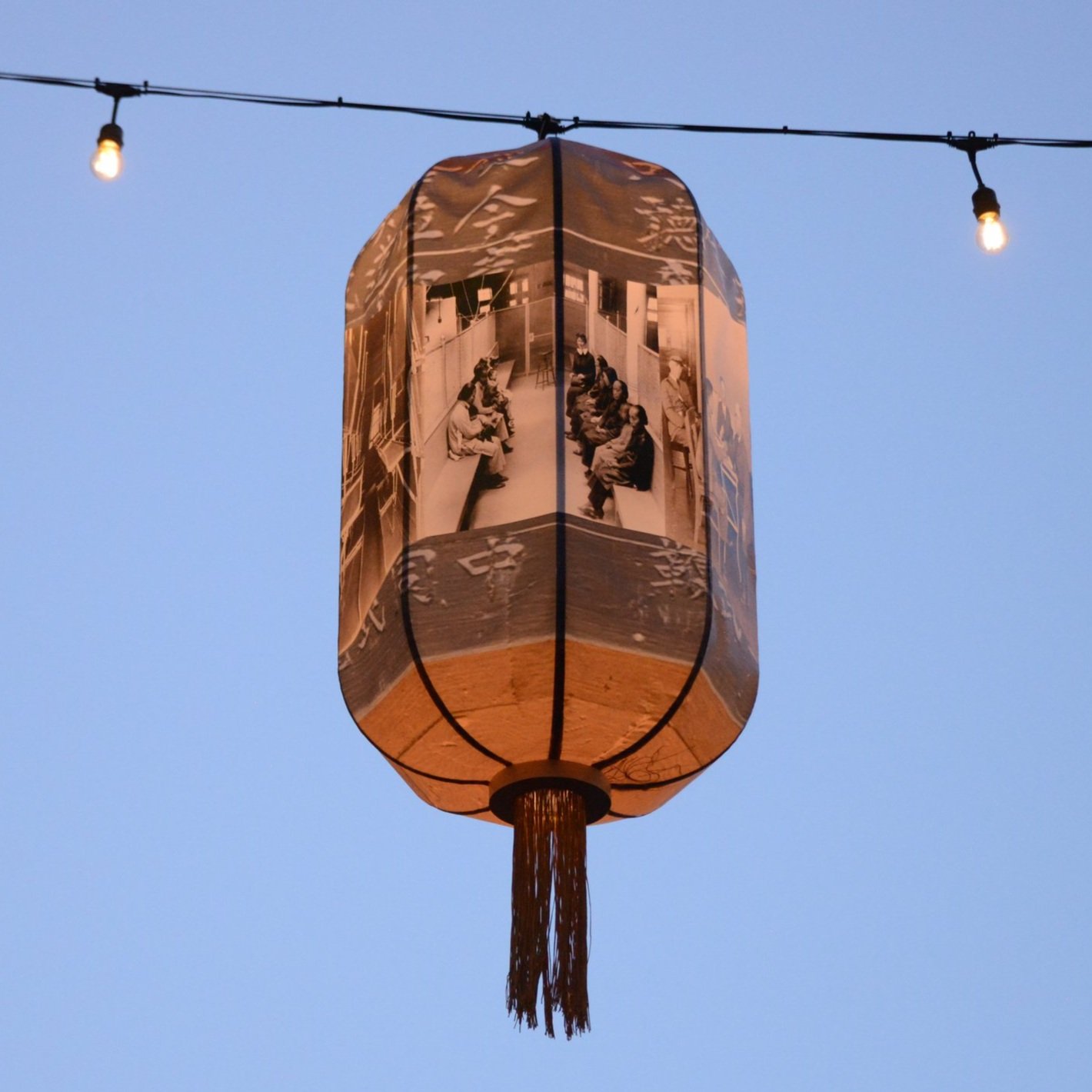
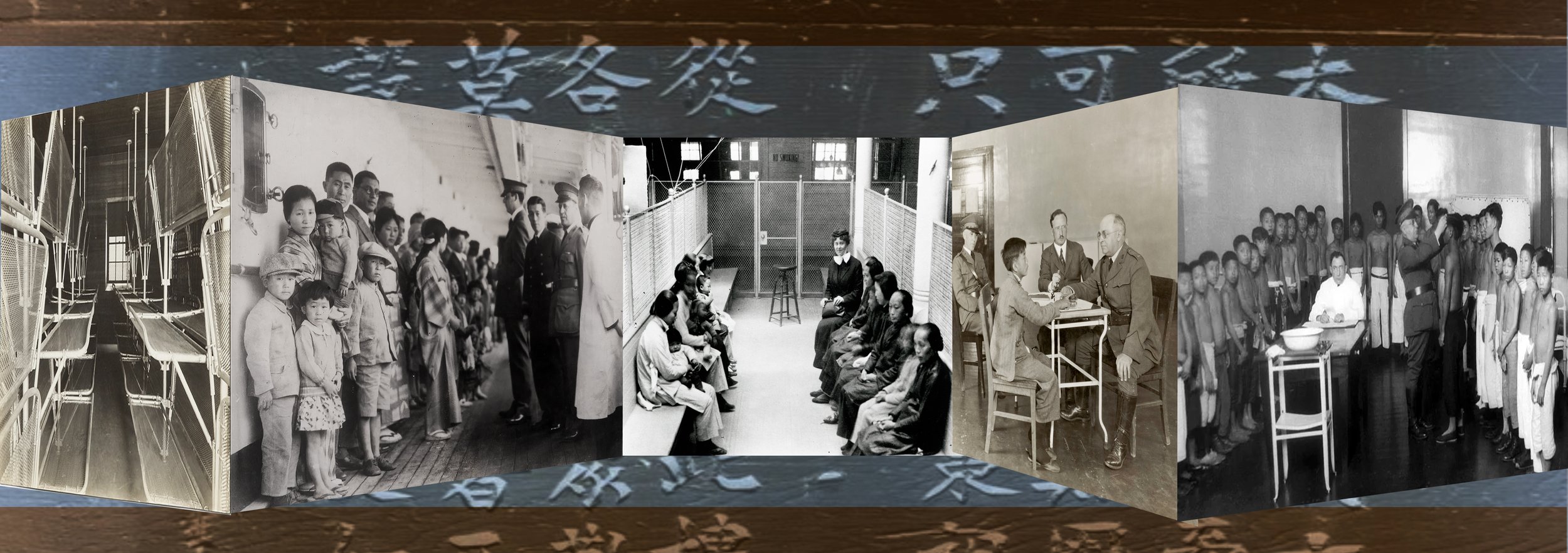
Angel Island
Built in 1910 in the wake of the 1882 Chinese Exclusion Act, the Angel Island Immigration Station was the West Coast’s main immigration facility until 1940. It was established to help regulate the flow of Asian immigration to the U.S. and employed discriminatory policies designed to detain immigrants from China, Japan, India, and other Asian countries for intensive inspection, and often deportation.
To circumvent the Exclusion Act, many Chinese individuals procured fraudulent identity papers claiming to be the “paper sons” or “paper daughters” of Chinese U.S. citizens. Due to this and general anti-Chinese sentiments at the time, Chinese immigrants were especially subject to endless interrogations and invasive physical screenings, lasting anywhere from weeks, to months, to years, all while held captive on the island under oppressive conditions. Meanwhile, European and first-class immigrants were met with little to no resistance, gaining immediate entry into the country. Many immigrants from China and other countries expressed their anxieties, fears, and deep despair by inscribing poems into the wooden walls of the detention barracks.
在1882 年美國政府通過《排華法案》後, 他們於1910 年在 Angel Island (天使島) 設置了移民管制站。直到1940年,這裡是美國西岸的主要移民管制處。 管制處的目的就是管制亞洲移民入境, 採用歧視性的政策拘留、檢查和驅逐來自中國、日本、印度及其他亞洲等國家的移民人士。
為了迴避《排華法案》,很多華人入境時提上了虛假的證件來稱自己是美國華裔公民的「紙兒子」或「紙女兒」。 由於這是常態,加上當時普遍的反華情緒,華人移民特別受嚴厲的審問和侵入性的身體檢查。他們被迫囚禁在島上數週、數月、甚至數年。 相反,歐洲及其他頭等移民入境幾乎沒有任可制阻。 很多來自中國和其他國家的移民在拘留營內的木牆刻畫了詩歌來表達他們的焦慮、恐懼和絕望。
1885 Map & Earthquake
As San Francisco’s Chinese immigrant population rose steadily in the 1870s, so did anti-Chinese sentiments. After the completion of the Transcontinental Railroad, railroad workers needed new jobs (often to support their families back in China) and white working-class Americans, fearing job market competition, reacted with hostility. Faced with discriminatory laws at the municipal level and racial violence on the ground, the early Chinese sojourners came together to form communities for protection that eventually became Chinatowns. The top lantern’s 1885 map of Chinatown reflects the anti-Chinese biases of this period, painting the neighborhood as a crowded slum rife with disease, gambling, opium, and sex work that “threatened the morals” of American society. Meanwhile, white tourists were its main customers, feeding the neighborhood’s infamous reputation while ignorant of its underlying issues of poverty, racial discrimination, and other inequities.
Later came the 1906 San Francisco earthquake, the largest in California’s history and one of the worst and deadliest natural disasters in U.S. history. An estimated 3,000 people were killed and over 80% of the city was destroyed, including all of Chinatown. 90% of the destruction was caused by subsequent fires in the four days afterward: the extent of the damage can be gleaned from the red outline on the bottom lantern’s map. Old Saint Mary's Cathedral, located on the same block as these lanterns, was Chinatown’s only surviving building. The city’s reconstruction committee had tried to relocate Chinatown after the earthquake. To save their community from being uprooted, Chinatown leaders convinced city officials and local landlords to rebuild buildings in an orientalist style—with architectural accents such as pagodas, curled eaves, and dragon motifs—to attract tourism and help revive the city’s economy.
Because the fires destroyed most of the city’s birth and immigration records, Chinese immigrants were suddenly given a clean slate and the chance to claim they were U.S. citizens. This allowed them to bring their families from China, as well as non-relatives who immigrated using fraudulent identity papers posing as their “paper sons.” Pictured in the child immigration portrait is the acclaimed artist Tyrus Wong (also featured in the “San Francisco Notables” lantern below), who immigrated as a paper son through Angel Island at just ten years old.
在1870年代,隨著舊金山的華人移民人口續步上升,反華情緒也隨之增加。 在跨大陸鐵路建成後,華人鐵路勞工需尋新的工作扶養在中國的家人。美國的白人勞工,因擔心就業市場競爭,並向華人表示敵意。 面對著排華法案和種族暴力,這批早期的華人勞工為了安全保障並聚居起來,慢慢組成了我們認識的唐人街。
最高的那盞燈籠展示了 1885 年的唐人街地圖,可見當時的排華偏見。該地圖把唐人街區描繪成一個擠擁的貧民窟,充滿疾病、賭博、鴉片和性工作,威脅美國社會的道德觀念。 同時,白人遊客卻是唐人街的主要客源,不但持續這區的負面聲譽,又對這區潛在的貧困、種族歧視和其他不公等問題一無所知。
後來,在1906 年,舊金山發生加州史上最大的地震。 這是美國史上最嚴重和最致命的天災之一, 估計有 3 千人喪生,城市超過 8 成被摧毀。這當中包括整個唐人街,它9 成的破壞是由隨後四天的火災造成,損壞程度可以從燈籠底部地圖以下的紅色輪廓看到。 舊聖瑪麗大教堂 —— 位於這些燈籠的附近——是唐人街唯一倖存的建築。 地震後,該市的重建委員會曾試圖把唐人街搬遷。 當時,為了防止這社區被連根拔起,一班唐人街的領袖成功提議及說服當地官員和地主把唐人街的重建工作加入東方建築特色,例如寶塔、捲曲屋簷和龍圖案等等,以吸引旅客和振興城市經濟。
由於大火摧毀了城市大部分的出生和移民記錄,這突然給予華人移民聲稱自己是美國公民的機會。 這讓他們能夠申請把家人帶來美國,以及把非親屬冒充為「紙兒子」進入美國。 燈籠上的圖像是著名藝術家 Tyrus Wong 黃齊耀小的時候。 他在十歲時以「紙兒子」身份在 Angel Island ( 天使島 ) 入境。黃會在以下「舊金山名人」的燈籠再出現。
Cameron House
This lantern commemorates the early history of Cameron House, a Presbyterian mission home founded in 1874 as a safe house for young Chinese immigrant women from sex trafficking and indentured servitude. When the 1882 Chinese Exclusion Act banned immigration for Chinese girls and women, many were smuggled into the U.S. by being sold into slavery—girls often by their own families—in what has been called the “Yellow Slave Trade.”
The sex trade was controlled by the Tongs, criminal Chinese gangs in Chinatown with ties to city government. Imprisoned in brothels and “cribs,” these young women faced cruel conditions of physical, psychological, and drug abuse, malnutrition, and disease, most dying 4-7 years after immigrating. Pictured is Donalinda Cameron, superintendent of the house from 1897-1934, who fought against the Tongs to rescue and protect over 2,000 Chinese girls and women from the sex trade and provide them with education and healing. Standing to her right in the center photo is Tien Fuh Wu. After her rescue from severe abuse in a gambling den, she became Cameron’s primary aide and devoted most of her life to tenaciously rescuing thousands of trafficked girls and women. Also pictured is Cameron’s mentee Tye Leung Schulze, who worked as a Chinese interpreter for the house and would later become the first Chinese American woman to vote in a U.S. primary election in 1912.
While Cameron House played an early and valuable role in protecting, educating, and empowering young Chinese women victimized by violence and abuse, the house’s later years are shadowed by mounting allegations of sexual abuse by former executive director and pastor Dick Wichman (1947-77): a troubling history that the house continues to reckon with. Today, Cameron House is a comprehensive social service organization that works with low-income and immigrant Asian youth and families through a variety of programs.
這盞燈籠是紀念金馬倫樓的早期歷史。成立於 1874 年,金馬倫樓是一座長老會傳教之家,幫助遭受性交易和奴役契約的華人年輕婦女移民提供安全歸宿。 當 1882 年的《排華法案》禁止了所有華人婦女和女子入境,她們很多結果被偷運入境,並有時被家人販賣為奴隸。這俗稱為「黃奴販賣」。
性交易由唐人街的犯罪黑幫「唐氏」操控,並與市政府有關連。 這些年輕女生囚禁在妓院內,面對著非常殘酷的環境,不但生理和心理上有創傷,還有藥物濫用、營養不良和疾病。她們大多數於移民四至七年後死亡。燈籠上的圖像是 多娜琳達·金馬倫(Donalinda Cameron)。 她在1897 年至 1934 年擔任長老會之家的院長,對抗唐氏黑幫和拯救超過二千多名華人婦女和女生免於性交易,並為她們提供教育和治療。 在圖片中,站她右側的是 Tien Fuh Wu。 吳被拯救前在賭場受到嚴重虐待,拯救後成為了金馬倫的主要助手,並奉獻了她的一生於營救數千名被販賣的婦女和女生。 圖中還有金馬倫的學徒 Tye Leung Schulze,她為長老會之家擔任中文翻譯,並在 1912 年美國初選成為第一位能投票的華裔美國女士。
雖然金馬倫樓在早期做了很多有關保護、教育、強化受害者的工作,但該機構在1947至1977年期間卻被前執行董事和牧師 迪克·威曼 (Dick Wichman) 的性虐待指控捲入醜聞,玷污了金馬倫樓的名譽。 如今,金馬倫樓是一個提供綜合性的社會服務機構,透過各種計劃幫助低收入和亞裔移民,尤其是年青人和家庭。
ACTIVISM / 行動主義
Stop Asian Hate
The Asian-American community have been active participants in civil rights and social justice protests throughout the 1900s to the current moment. The term “Chinese virus” is the latest brand of xenophobia and sinophobia arising from the COVID-19 pandemic, prompted by the misconception that individuals of Asian (and especially Chinese) descent are more likely to carry and spread the virus due to its early detection in China. The red banner pictured, “Fight the Virus, Not the People,” was used in a February 2020 march at the SF Chinatown Gate. This protest cry, used at many demonstrations across the United States, aimed to dispel harassment, prejudice, and violence against Chinese and Asian individuals of every descent, and to divert such negative hypervisibility toward productive means of combating the virus.
Also pictured is Russell Jeung, co-founder of the Stop AAPI Hate coalition launched in March 2020 as a means to track and respond to incidents of hate, violence, harassment, and discrimination against Asian Americans and Pacific Islanders in the United States. Between March 2020 and March 2022, more than 11,400 hate incidents against Asian Americans have been reported in the US. This lantern seeks to honor the memory of many individuals who have fallen victim to recent, violent hate crimes in San Francisco and beyond, including: Xiao Zhen Xie, Ngoc Pham, and other Asian American elders who were assaulted and robbed in San Francisco; the murder of Vicha Ratanapakdee; the six Asian American women murdered in the 2021 Atlanta spa shootings; and countless others.
‘在整個二十世紀至今,亞裔美國人社區一直是公民權利和社會正義抗議活動的積極參與者。“中國病毒”一詞是新冠疫情期間出現的排外主義和反華主義的最新代表,這是由於人們誤認為亞洲人(尤其是華人)的後裔更容易攜帶和傳播這種病毒,因爲該病毒早期發現於中國。在2020 年 2 月,遊行人士在舊金山的唐人街牌樓舉起了紅色的橫幅標語:「對抗病毒,不對抗人民」。 該抗議口號在美國各地的示威運動非常普及,目的是希望消除針對華人和亞裔人士的歧視、偏見和暴力行為,及把這種負面的態度轉移到有效抗擊病毒的信息上。
在照片裏面的另一人是張華耀,他是停止反亞裔仇恨聯盟(Stop AAPI Hate)的聯合創始人。停止反亞裔仇恨聯盟創立於2020年3月,旨在追踪和回應針對亞裔何太平洋島民的仇恨、暴力、騷擾和歧視事件。在 2020年3月至 2022年3月期間,在美國有超過 11,400針對亞裔美國人的仇恨事件被申報。這個燈籠紀念多名最近在舊金山或其他地方受到仇恨暴力的受害者,包括:Xiao Zhen Xie、Ngoc Pham 、在舊金山遭襲和搶劫的亞裔美國長老、被殺害的 Vicha Ratanapakdee 、在 2021年亞特蘭大水療槍擊案被殺害的六名亞裔美國婦女和無數其他人。
ENTREPRENEURSHIP / 企業家精神
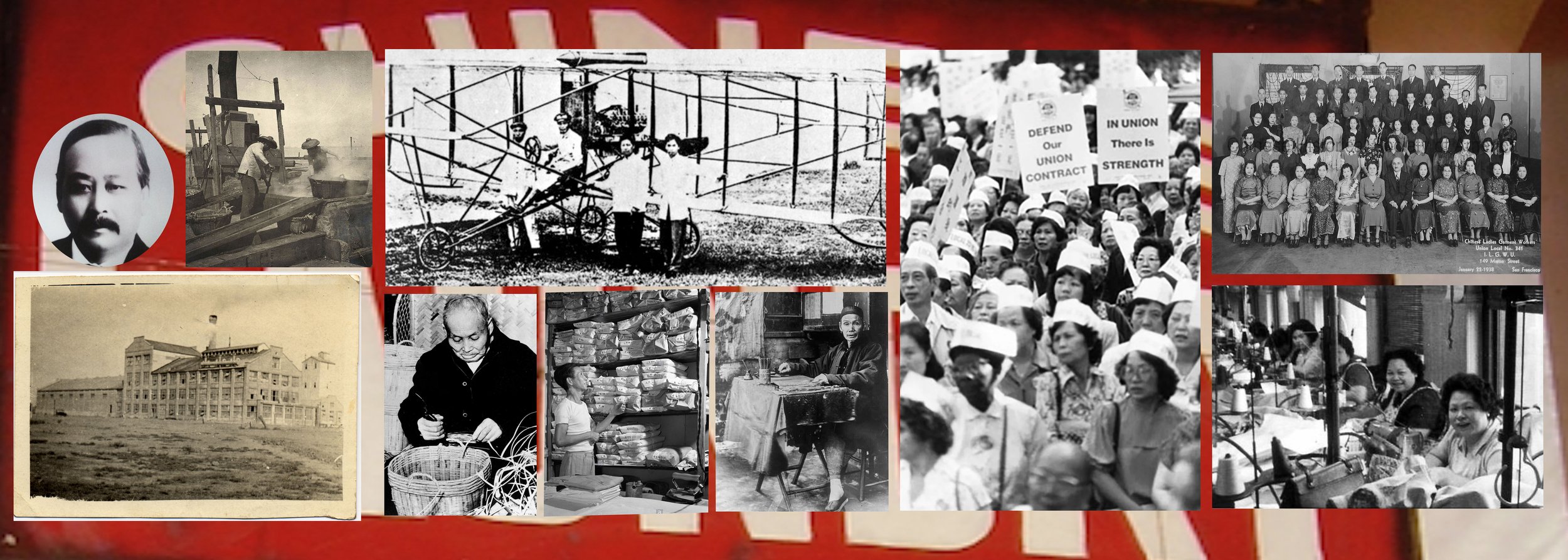
Entrepreneurship / 企業家精神
San Francisco’s earliest Chinese laborers and entrepreneurs made major contributions not only to the economy, but also in terms of civil rights. Amid the 1850’s slim and racially discriminatory job market, male Chinese immigrants found their most dependable enclave in the laundry industry, comprising 89% of San Francisco’s laundry workforce by the end of the century. The first ever Chinese-owned laundry business in the U.S. was opened in San Francisco by Wah Lee in 1851.
Concentrated in Chinatown, the success of San Francisco’s garment industry depended largely on the labor of Chinese immigrant women, who dominated the industry’s workforce by 1920. These women made significant strides in labor organizing, founding organizations such as the Chinese Ladies Garment Workers Union (group photograph) and led major demonstrations such as the 1938 National Dollar Store/Golden Gate Manufacturing Strike to lobby for safer working conditions and wage equality.
SF Chinatown’s earliest Chinese immigrants made their living through skill-based labor and entrepreneurial pursuits such as fortune telling, basket weaving, and shrimping. Pictured is Chinese-American industrialist Lew Hing, canning industry pioneer and founder of the Pacific Coast Canning Company, who became one of the wealthiest Chinese immigrants in the U.S. He is remembered by some as the Father of Chinatown: in the wake of the 1906 earthquake, he opened his cannery as a shelter and soup kitchen for members of the Chinatown community who lost their homes. Also pictured is Feng Ru, known as the Father of Chinese Aviation. A self-taught engineer, he became the first person to pilot an airplane of his own design on the West Coast in 1909.
舊金山最早期的華人勞工和企業家不僅對經濟付出重大貢獻,在公民權益上也貢獻良多。 在 1850 年代渺小和充滿種族歧視的就業市場中,華人移民在洗衣業找到了一個可靠的市場。在十九世紀末,華人移民佔舊金山洗衣勞動力的百分之八十九。 在1851 年,美國的第一家華人擁有洗衣店在舊金山開業,店舖老闆為 Wah Lee。
舊金山的紡織業其成功背後的原因全因為依賴華人女工。集中於唐人街,該行業在1920 年由華人女工主導。這些女工為業界人士組織工會,創立了中華紡織業界女工工會(可見團體照)及領導大型示威運動。這包括 1938 年的國家美元店/金門製造業罷工,以爭取更安全的工作條件和工資平等。
舊金山唐人街最早期的華人移民主要靠特定技能、算命、織籃子和捕蝦等活動謀生。 這個燈籠圖像上為美籍華橋實業家劉興,他是罐頭業先驅和太平洋海岸罐頭公司的創辦人,並是美國最富有的華人移民之一。 在1906 年地震後,他把罐頭廠開放給失去家園的社區成員,並化罐頭廠為避難所和施食處,社區人士稱他為「唐人街之父」。 圖中的另一人是被譽為中華航行之父的馮如。 馮是一名自學成才的工程師,並於 1909 年成為第一個在西岸駕駛自己設計的飛機的先驅。
Restaurants / 飯店
San Francisco is home to some of the first Chinese restaurants in America. Opening in the 1850s, they originally catered to Cantonese miners and railroad workers. To attract non-Asian clientele, restaurants began marketing themselves with a combination of traditional Chinese appeal, modern Western style and increasingly sweet, mildly-spiced, and deep-fried dishes to suit American palates. Chop Suey joints, a Chinese American invention that translates to “Odds & Ends,” were a particularly popular destination among young urbanites. By the 1880s, high-class Chinese restaurants were growing in popularity among all Americans.
Opened in 1849 in San Francisco, Canton Restaurant was the first known Chinese restaurant in North America. Pictured are vintage menus of other historic SF restaurants—some of which are still serving today—including Sam Wo (established after the 1906 earthquake), Far East Cafe (est. 1920), and Kan’s restaurant founded by famous Chinatown restaurateur Johnny Kan. To attract tourists, many restaurants embraced orientalist decor and, to appear modern, advertised their establishments with neon signage like that of Li Po Cocktail Lounge (pictured). SF Chinatown had the highest concentration of neon signs in the city, emblematic of the neighborhood’s vibrant nightlife.
Established in 1962, The Golden Gate Fortune Cookie Factory is a local landmark and remains one of the few places left in the country to find handmade fortune cookies. Also pictured are Chinese mooncakes, a delicacy usually eaten on the occasion of the Mid-Autumn Festival in October.
舊金山是美國首個中菜館的所在地。 啟業於1850 年代,這些餐館最初主要服務廣東礦工和鐵路工人。 為了吸引非亞裔顧客,有些餐館並開始混合傳統中式的魅力和西式味道,把菜餚增甜、添微辣和增加油炸等菜色以迎合美國人的口味。 雜碎店是一項美國華橋的創意,特別受年輕都市人的歡迎。 到1880 年代,高級中餐館在美國甚受歡迎。
開啟於 1849 年的舊金山,Canton Restaurant (廣東餐館)是北美首家中菜館。 圖中是其他歷史悠久的舊金山餐廳的舊式菜單。至今,這些餐廳還有一部分存在,包括 Sam Wo(在 1906 年地震後成立)、遠東咖啡館(建於 1920 年)和由著名唐人街餐館老闆 Johnny Kan 創立的 Kan's Restaurant。 要吸引遊客,許多餐廳採用東方的裝飾。為了顯得現代,他們用霓虹燈牌宣傳他們的餐廳,如圖的 Li Po 雞尾酒酒廊。 舊金山唐人街是全市凝聚最多霓虹燈的地方,象徵著該社區的活力和夜生活。
成立於 1962 年,Golden Gate Fortune Cookie Factory 金門幸運餅鋪是當地具有地標性的建築,也是全國所剩無幾的手作幸運餅鋪之一。 圖中還可見中秋節時常吃的月餅。
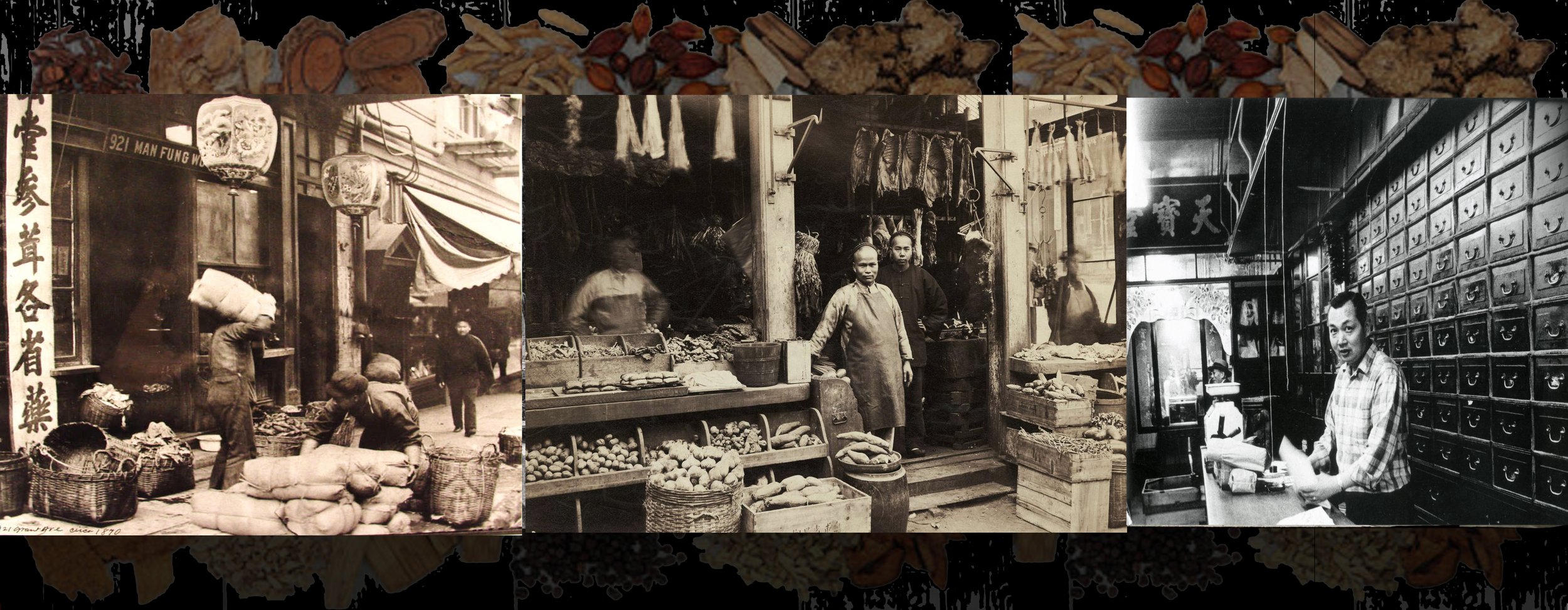
Apothecary & Grocery / 藥劑師和雜貨店
Featured in these images are San Francisco grocers, butchers, and apothecarists. Chinatown grocery stores operated on multiple fronts: as food markets, they sold food products such as fish, vegetables, tea, and basic household goods. As apothecaries, they sold herbal ingredients for traditional Chinese herbal medicine. These establishments also served as social hubs, community information centers, and sometimes as credit unions for sending money overseas.
這些圖片可看到舊金山的各種雜貨店、肉店和藥劑店。 唐人街的雜貨店經營範圍甚廣——它們既是食品市場,出售魚類、蔬菜、茶葉和基本家居用品, 亦是藥劑店,出售中醫藥材。 這些店舖都是社交場地、信息中心,還有時是海外匯款社。
Printing / 印刷
Rather than newspapers, the fastest and most effective means of spreading news and engagement among the earliest Chinatown residents was through street-accessible bulletin boards. Listings included job openings, cultural events, items for sale, and other resources for Chinatown residents. During wartime, the bulletin also served as a resource to learn about news from China first-hand.
Pictured in the portrait is Ng Poon Chew, author, civil rights advocate, and publisher of Chung Sai Yat Pao, the first Chinese-language daily newspaper to be printed outside of China. Published from 1900-1951, it was one of the longest-running and most popular newspapers of its kind in the United States. Chew’s paper connected the SF Chinatown and Chinese immigrant communities at a time when Chinese-language news sources were few and far between. He commissioned correspondents stationed in China for reportage on wars, natural disasters, politics, and educational and economic progress in mainland China. The paper also covered American news related to Chinese immigrants and legal and political issues concerning the Chinese, such as restrictions on importing and changes to immigration laws. Prior to Chinese typewriters, letter presses were the only printing technology available. Seen in the photos are walls of 7,000 metal moveable types of Chinese characters used in typesetting at the time.
唐人街在早期最快和最有效的通信方式並不是報紙,而是街頭的公告板。 公告板上有職位招聘、文化活動、待售物品及其他服務居民資源的公告。 在戰時,該公告板亦成為第一時間了解中國新聞的資源庫。
這燈籠圖像的人物是作家、民權倡導者和《中西日報》出版人Ng Poon Chew。《中西日報》是第一份在中國境外印刷的中文日報。出版於 1900 至 1951 年,《中西日報》是美國發行時間最長和最受歡迎的報紙之一。在一個中文新聞稀少、貧乏的時候,這報章把舊金山唐人街和華人移民聯繫在一起。他委託駐華記者報導有關中國大陸的戰爭、自然災害、政治、教育和經濟發展。該報還報導了有關美國的中國移民新聞,包括有關中國移民的法律和政治等問題——例如進口限制和修改移民法,等等。在中文打字機還沒有被發明前,活字印刷機是唯一的印刷技術。你可以從圖像看見7000個金屬活字掛在牆上。
PEOPLE (LIFE) / 人物(生命

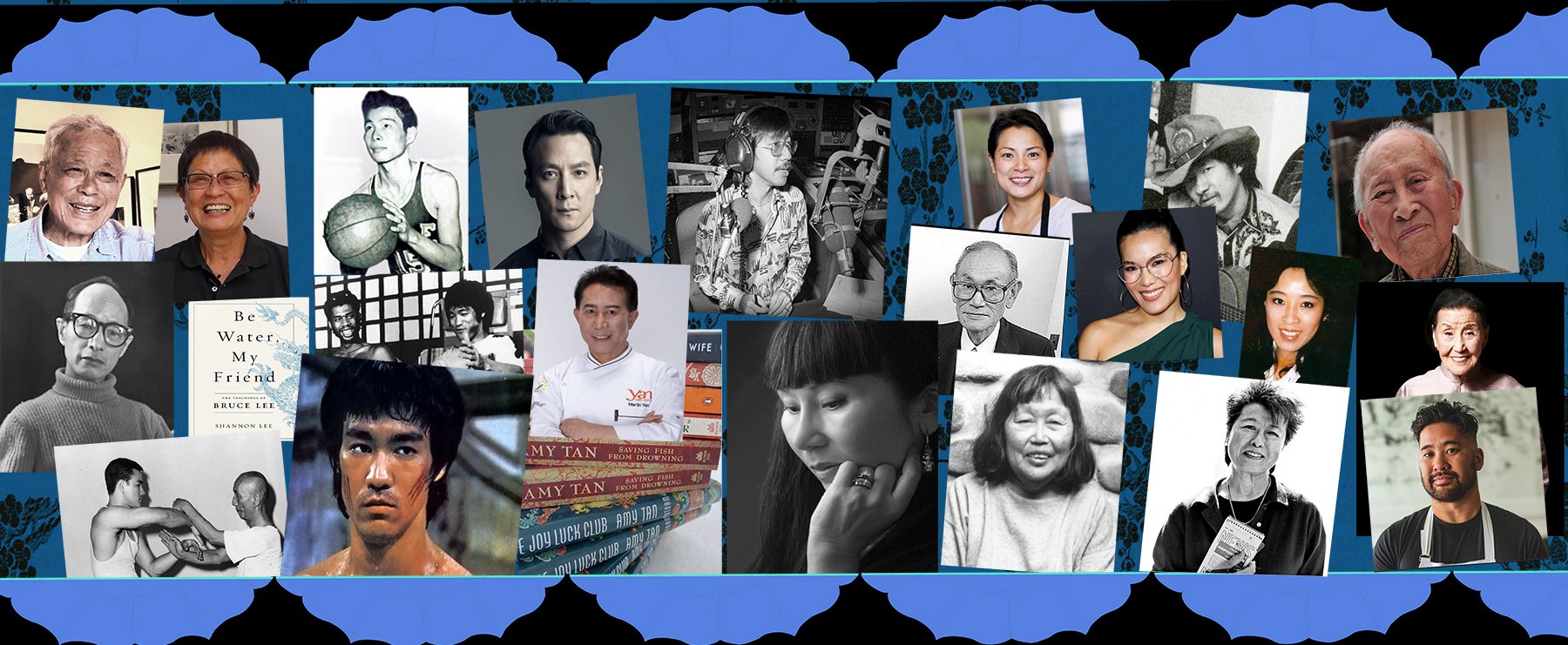
San Francisco Notables
This lantern brings together some of the many notable Asian American figures, both living and in legacy, with ties to the San Francisco Bay Area. One of the biggest names to hail from San Francisco is martial artist, actor, filmmaker, and philosopher Bruce Lee, who made significant contributions to the Chinatown and Bay Area communities. He is shown as a teenager in the bottom left photograph training with his only shifu/sifu, Wing Chun grandmaster Ip Man.
Also shown is American hero Betty Ong, the flight attendant who first alerted authorities of the 9/11 airplane hijackings, and one of many aboard American Airlines Flight 11 that crashed into the North Tower of the World Trade Center.
Featured writers, artists, and innovators include Amy Tan, author of Joy Luck Club and other books; artists Ruth Asawa and Martin Wong, photographers Benjamin Chinn, Charles Wong, and Irene Poon; chefs and restaurateurs Brandon Jiu of Mister Jiu’s, Cecilia Chang of The Mandarin, Belinda Leong of b. Patisserie, and Martin Yan of Yan Can Cook; Ben Fong-Torres, journalist for Rolling Stone and SF Chronicle; Fred Kormatsu, civil rights activist; Ali Wong, actress and comedian; Daniel Wu, actor, director, and producer; Tyrus Wong, artist, kite maker, and lead illustrator on Disney’s Bambi and other productions; Willie “Woo Woo” Wong, acclaimed basketball player; and Helen Zia, journalist and activist. All together, these twenty remarkable individuals will forever be a source of pride and inspiration for the SF Chinatown and Bay Area communities.
這盞燈籠匯集了與舊金山灣區有關係的著名亞裔美國人。其中一個最著名的名人就是來自舊金山的武術家、演員、電影製作人和哲學家李小龍。他為唐人街和舊金山灣區的社區有甚大的貢獻。 在左下角的照片中,他只有十幾歲,並和他唯一的師傅——詠春大師葉問一起訓練。
燈籠還展示了另一位美國英雄 Betty Ong。她是第一個向當局報告 9/11 飛機劫持事件的空姐,也是墜毀在世界貿易中心北塔的美國航空 11 號眾多乘客之一。
其他著名人士有作家、藝術家和發明家,包括 Joy Luck Club 作者 Amy Tan; 藝術家 Ruth Asawa 和 Martin Wong,攝影師 Benjamin Chinn、Charles Wong 和 Irene Poon;廚師和餐館老闆 Mister Jiu 的 Brandon Jiu、The Mandarin 的 Cecilia Chang、b. Patisserie 的 Belinda Leon 和 Yan Can Cook 的 Martin Yan;滾石和舊金山 Chronicle 的記者 Ben Fong-Torres;民權倡議家 Fred Kormatsu; 演員和喜劇演員 Ali Wong;演員、導演及製片人 吳彥祖;藝術家、風箏勞作者及迪士尼小鹿斑比和其他作品的首席插畫師 Tyrus Wong 黃齊耀; 籃球運動員 Willie “Woo Woo” Wong; 和記者及社區倡議人士 Helen Zia。 這總共二十位傑出的人士將永遠成為舊金山唐人街和舊金山灣區的驕傲和靈感源泉。
Family / 家庭
As Chinese immigrants faced unrelenting discrimination and violence at both municipal and interpersonal levels, San Francisco’s Chinatown grew into an extremely self-sufficient, insulated, and tight-knit community. Everyone knew each other by their names and nicknames and families leaned on one another for support. Beginning as a “bachelor” society of male Chinese laborers (the U.S. deliberately enacted policies that forbid the immigration of wives and families), Chinatown became a family town after the 1943 repeal of the 1882 Exclusion Act. Additionally after World War II, the War Brides Acts of 1945 and 1946—originally intended to help the European wives and girlfriends of American G.I.’s enter the U.S.—unintentionally also benefited the wives of Chinese-American soldiers. Children born from these family reunions in the mid-40’s would become the first well-educated, bilingual, bicultural, and professional generation of Chinese Americans.
Pictured on the lantern is the late photographer Kem Lee, who for five decades captured a rich archive of nearly every aspect of life in his Chinatown community, from everyday scenes of children playing in the streets, to the Miss Chinatown USA Pageant and other neighborhood functions. Pictured in the color photographs are modern-day Chinatown residents in Portsmouth Square, San Francisco’s first public plaza that continues to be a civic center for today’s Chinatown community.
Pictured in the dual portrait are May and Sinclair Louie, two beloved pillars of SF Chinatown since the mid-20th century. As business owners, activists, and philanthropists, this dynamic duo founded the Chinatown Merchants Association, the annual Autumn Moon Festival, and the Robert J. Louie Memorial Fund which continues to support small businesses and the SF Chinatown community.
雖然華人移民在社會裡面對種種歧視和暴力,但是舊金山的唐人街卻成為了一個能夠自給自足和一個大家關係緊密的社區。 大家都認識彼此的名字和暱稱,亦會互相依靠和幫助。 鑑於美國1882 年的《排華法案》政策禁止妻子和家人移民,唐人街最初是一個「單身漢」的社會,並在 1943 年法案廢除後才成為了一個有家庭的社區。 此外,在1945 至 1946 年 二戰大戰後的《戰後新娘法案》——原意是幫助美國兵迎娶歐洲妻子和女朋友入境美國 ——也無意受益了華裔美國士兵的妻子。 在 40年代中期因這些家庭團圓中出生的孩子便成為了第一代有優良教育、能說雙語、有雙文化和專業的華裔美國人。
這燈籠上的圖像是已故攝影師 Kem Lee。 他五十年來拍攝了唐人街社區的豐富生活點滴——由孩子在街上玩耍、美國唐人街小姐選美大賽和其他社區活動。 彩圖裡可見唐人街居民身處於現今的朴茨茅斯廣場。這是舊金山的第一個公共廣場,至今仍是唐人街的社區中心。
燈籠上的雙人圖像是May 和 Sinclair Louie。她們是 20 世紀中很受愛戴的唐人街橋樑。 作為企業家、社運家和慈善家,她們創立了唐人街商會、一年一度的中秋節慶祝活動和 Robert J. Louie 紀念基金來支持唐人街和小企業。
Education / 教育
Education has always been an important focus of the Chinese culture and of Chinese American immigrants. San Francisco's first public school for Chinese immigrants was established in 1859 and designed to segregate Chinese children from white children. By the time of the 1885 case Tape v. Hurley, Chinatown residents took to protesting school segregation and other educational inequalities. Pictured in one photo is the Tape family, who sued the state of California for denying their U.S.-born daughter admission to an all-white public school because of her Chinese ancestry. The case determined that such exclusion based on ancestry was unlawful, and guaranteed the right of children born to Chinese parents to public education. Although this exclusion continued through subsequent policies, the decision helped to pave the way for the future integration of public schools.
It was not until 1971 that San Francisco schools were officially desegregated, yet unequal treatment of Chinese students (along with other students of color) prevailed. A landmark case in bilingual education history, the 1974 case Lau v. Nichols determined the failure of the San Francisco school system in providing English instruction to approximately 1,800 Chinese students who did not speak English. The case’s outcome entitled students with limited English proficiency to the right to language assistance, ensuring a meaningful education. Featured in the background imagery of this lantern is bamboo, a Chinese symbol of youth, strength, longevity, and achievement, and also one of the earliest writing surfaces in Chinese history.
中國傳統文化和美國華裔移民一向都特別注重教育。 在1859年,舊金山成立了第一所華人移民公立學校,目的是把華人和白人孩子分開教育。 直到 1885 年 《Tape v. Hurley》 案審判時,唐人街居民才開始抗議學校制度屬歧視性和有教育不平等的現象。 燈籠上其中一張圖片是 Tape 的全家。他們控告加州拒絕取錄他們在美國出生和有中國血統的女兒入讀一所白人的公立學校。 該案認定這種基於血統的排斥是非法的,並保障了華人所生的孩子有平等的公共教育權利。 雖然這種排斥仍有在其他方面繼續,但這判決助長了後來公立學校的融合。
直到 1971 年,舊金山的學校才正式廢除種族分歧教育,可是華裔和其他有色人種的學生仍有受到不平等的待遇。 在1974 年,一則有關雙語教學的案例《Lau v. Nichols》判決了舊金山學校制度未能為大概 1,800 名英語水平有限的華人學生提供英語教學。 該法案判決令這些學生有權獲得語言援助,確保教育受益。
這盞燈籠的背景圖案是竹,象徵著青春、力量、長壽和成就,也是中國歷史上最早的書寫媒介之一。
Festival & Performance / 節日
Chinese festivals typically revolve around the lunisolar (rather than lunar) calendar, in which months begin on the day of the new moon, and years on the second or third new moon after the winter solstice. New Year festivities in China, therefore, celebrate the start of Spring and are better known as the Spring Festival (rather than “Chinese New Year” or “Lunar New Year” festival, as it is known in the U.S). Other popular traditional Chinese festivals include the Mid-Autumn Festival and the Lantern Festival. Pictured in the center is Maggie Wong, SF Chinatown’s empress of the annual Mid-Autumn Moon Festival, during which she performs across Chinatown as the Moon Goddess. Another popular event pictured is the Miss Chinatown USA Pageant, established in 1958 and still running today as a Lunar New Year event.
A major part of Chinese culture, the performing arts became a major industry in SF Chinatown, including traditional Chinese opera: a dramatic, acrobatic, and elaborately costumed form of musical theater dating back to the Song Dynasty or earlier. It was common for male actors to play female roles known as dan (and later on, vice versa), as pictured in the righthand lithograph. From the mid-1930s to 1970, SF Chinatown saw the peak of its Chinese American nightclub scene, with clubs such as Forbidden City, the Kubla Khan, and Shangri-La, and burlesque stars such as the famous Coby Yee (who would later become the owner of Forbidden City). Pictured on the lower left are the Grant Ave Follies, a dance troupe of older Asian women founded in SF Chinatown, who continue to tour performances across the country.
中國的節日圍繞著陰陽曆(而不是農曆),月份由初一新月開始,年份由冬至後第二或第三個新月開始。 因此,中國新年亦稱為春節,慶祝春天的來臨。 其他受歡迎的中國傳統節日包括中秋節和元宵節。 燈籠圖中是舊金山唐人街的中秋節娘娘 Maggie Wong,她每年都會在中秋扮演嫦娥。 另一個受歡迎的節目是美國唐人街小姐選美大賽。成立於1958 年,這至今仍每年在農曆新年舉行。
表演藝術是中國文化裡重要的一部分,亦是舊金山唐人街的主要產業之一。這包括由早於宋代開始的中國傳統戲曲,包含雜技和精美的服裝。 從右圖可見,男演員會經常扮演女角色 —— 俗稱「旦」。(後來,女演員亦會扮男)。 由 1930 年中期到 1970 年,舊金山唐人街見證了其華裔夜總會最豐盛的年代,包括紫禁城、忽必烈汗和香格里拉等俱樂部和著名的滑稽明星 Coby Yee(她後來紫禁城老闆)。 燈籠左下的圖像是 Grant Ave Follies,一隊在舊金山唐人街的中年阿姨舞蹈團。她們至今還在全國巡迴演出。
Lions / 獅子
The lion is a frequent animal subject in Chinese myths and is a symbol of power, wisdom, and promise. Traditional Chinese lion dances are performed during the Chinese New Year Festival (or Spring Festival) and other occasions to pray for good fortune and prosperity for the coming year and to deflect the interference of evil spirits. The dance is influenced by martial arts and performed in a wide variety of styles (depending on the region of China) by two dancers per lion costume, accompanied by a raging rhythm of drums, cymbals, and gongs.
獅子是中國神話中經常出現的動物題材,是力量、智慧和諾言的象徵。在農曆新年(或春節)期間和其他場合進行傳統的舞獅表演,以祈求來年的吉祥和繁榮,並轉移邪靈的干擾。舞蹈受到武術的影響,表演風格各異(取決於不同中國地域)。每位獅子戲服需要兩名舞者,舞獅通常伴隨著鼓、鈸和鑼的激烈節奏。
ARTS / 藝術
Calligraphy
The art of calligraphy is an important part of Chinese culture and education. It translates to “method/way of writing” and historically was considered the ultimate form of artistic expression above painting and sculpture. Contributing to the lanterns are three Boston-based calligraphers: Maurice Chi, Peter Ng, and Mike Mei.
書法藝術是中國文化教育的重要組成部分。它從字面上翻譯為“美麗的書寫”,在歷史上被認為是凌駕於繪畫和雕塑之上的藝術表達的最終形式。為燈籠的做出貢獻的是三位波士頓書法家:Maurice Chi,Peter Ng和, Mike Mei。
Zodiac / 生肖
Inspired by traditional Chinese papercuts, this drawing by Yu-Wen Wu displays the twelve animals of the Chinese Zodiac: the Rat, Ox, Tiger, Rabbit, Dragon, Snake, Horse, Sheep, Monkey, Rooster, Dog, and Pig. These animals are used to represent each of the twelve years in the Zodiac’s cycle and, depending on one’s birth year, are believed to inform one’s personality, fortune, and compatibility with others, among further traits.
The bordering medallions are represented by the character 福 (fu) and symbolize blessings. Additionally, the entwined plants of bamboo, lotus, chrysanthemum, pine tree, and peach all signify longevity, among other qualities: bamboo for suppleness, strength, endurance, and flexibility, the lotus flower for enlightenment, the chrysanthemum flower for intellect, cleansing, and curing, and the pine tree for steadfastness, self-discipline, endurance, and a long life.
在中國傳統剪紙的啟發下,吳育雯的這幅畫展示了十二生肖:鼠、牛、虎、兔、龍、蛇、馬、羊、猴、雞、狗和豬。每十二年為一個生肖周期,這些動物分別代表其中的每一年。並且根據一個人的出生年份,生肖被認為可以傳達一個人的個性、財富以及與其他人的相處性,以及其他特徵。
毗鄰的紀念章以福為代表,象徵著祝福。此外,竹子、蓮花、菊花、松樹和桃子交織在一起而成的植物都代表著長壽,以及其他品質:竹子具有靈活性、力量、耐力和柔韌性;蓮花具有啓迪性;菊花具有理智、清潔和治愈性;松樹具有堅固性、自律性、耐力和長壽命。
Moon Goddess / 月亮女神
The story of the Chinese moon goddess Chang’e (嫦娥) is an important myth in the Chinese canon and is typically celebrated during the Mid-Autumn Festival. There are many versions of this legend. One version is that her husband and archer Hou-Yi, shot down nine suns in order to save the earth from being scorched. As a reward, he was given an immortality elixir by an immortal. Soon, an evil apprentice steals this elixir for Chang’e, who drinks it to become the spirit and goddess of the moon. She then flees to the moon and leaves her husband behind. A rabbit (pictured in the lower right) pities her and goes to the moon to keep her company and prepare more immortality elixirs for her. Back on earth, her husband leaves her favorite desserts and fruits out at night to demonstrate his forgiveness and symbolically provide her with his company. Those who celebrate the Mid-Autumn festival often partake in this same practice symbolizing the family reunion and appreciate the full moon.
Many of the immigrants to Boston’s Chinatown are from the region of Guangdong (Canton province). Representing this region in the bottom left corner is a sampan (三板), a Cantonese term for a flat bottom sailboat translating to “three planks.” Sampans are used for shelter (both temporary and permanent) on inland waters of southern China and Southeast Asia. The Sampan is also the idea of charting new courses.
月亮女神嫦娥的故事是中國經典中的一個重要神話,通常在中秋節期間慶祝。此傳説有很多版本。一種版本是她的弓箭手丈夫後羿為了射下了九個太陽,以免地球被烤成一片焦土。作為獎勵,仙人給了他長生不老藥。不久,一個邪惡的學徒為嫦娥偷走了這長生不老藥,嫦娥喝下它,成為了月亮的靈魂和女神。然後,她逃到月球,把丈夫留在了身後。一隻兔子(右下圖)可憐她,並登上月球陪伴她,並為她準備了更多的長生不老藥。在地球上,她的丈夫在晚上把她喜歡的甜點和水果留在外面,以表達對他的寬恕並象徵性地為她提供陪伴。那些慶祝中秋節的人經常延續這個象徵家庭團圓和欣賞滿月的習俗。
波士頓唐人街的許多移民來自廣東地區。代表這一區域的是左下角的三板。它是粵語中的平底帆船,翻譯為“三塊木板”。在中國南方和東南亞的內陸水域,三板用於提供庇護(臨時的和永久的)。三板也代表開拓新航向的理念。
Global Migration Map / 全球遷移地圖
Extracted from Yu-Wen Wu’s series of drawings “Mapping Stories,” pictured is a migration map charting the global migration patterns of 2018. Historically and now, America offers the opportunity for a new life for immigrants who flee from war, persecution, and economic hardships. “Streets paved in gold” (interpreted here materially here by strips of gold leaf) was a common metaphor for that dream in anticipation of arriving at a new place of promise.
摘自吳育雯的“Mapping Stories”系列繪畫,圖為一張繪製了2018年全球移民格局的移民地圖。從歷史上到現在,美國為逃離戰爭、迫害和經濟困難的移民提供了新的生活機會。“黃金鋪成的街道”(在這裡由金葉實質性地解釋)是期望到達一個新的希望之地的普遍比喻。
Community Statements / 社區陳述
These community statements were gathered from Boston residents by artist Yu-Wen Wu, as well as from SF Chinatown residents by artist Erin Zhao during the inaugural Chinatown Art Festival, Neon Was Never Brighter, hosted by Chinatown Media and Arts Collaborative in April 2022. Their responses share stories of their family’s history, the current issues facing Chinatown, and what they hope for Chinatown moving forward.
Haoyun Erin Zhao is a multidisciplinary artist based in San Francisco, California, working in printmaking, painting, sculpture, and installation.
這些社區陳述先後由藝術家吳育雯和 Erin Zhao在波士頓和舊金山採錄。 舊金山的陳述於 2022 年 4 月唐人街媒體和藝術合作組織主辦的首屆唐人街藝術節 Neon Was Never Brighter 期間收集。居民分享了有關他們的家庭歷史故事、唐人街現時面臨的問題, 及他們對這社區未來抱有的希望。
ARTIST LANTERNS
With the interest of creating bicoastal exchange between the arts scenes in Boston and SF Chinatowns, Yu-Wen Wu invited artists engaged in these communities to lend their artwork to the creation of five brand new lanterns, yielding works from Yuko Okabe (Boston), Kathy Wu (Boston), and Christine Wong Yap (SF); Fred Liang (Boston), Lucy Kim (Boston), and Summer Mei Ling Lee (SF); Joanna Tam (Boston) and Lenora Lee (SF); Ponnapa Prakkamakul (Boston) and Cathy Lu (SF); and Phillip Hua (SF) and Wen-ti Tsen (Boston).
為了在波士頓和三藩市唐人街的藝術生態建立兩岸交流,吳育雯邀請了在這些社區互動的藝術家借出他們的作品去創作五個全新的燈籠。這些藝術家包括:Yuko Okabe(波士頓)、Kathy Wu(波士頓)和 Christine Wong Yap(三藩市); Fred Liang(波士頓)、Lucy Kim(波士頓)和 Summer Mei Ling Lee(三藩市); Joanna Tam(波士頓)和 Lenora Lee(三藩市); Ponnapa Prakkamakul(波士頓)和 Cathy Lu(三藩市); Phillip Hua (三藩市) 和 Wen-ti Tsen (波士頓)。
Yuko Okabe (Boston), kathy wu (Boston), and Christine Wong Yap (SF)
Yuko Okabe (Top left)
Top left: Community is a Garden-Mutual Aid, 2021, Digital
Yuko Okabe (she/they) is an illustrator and cultural worker playing at the intersection of youthful whimsy and community engagement. She received a BFA in Illustration from the Rhode Island School of Design. Previous fellowships include RISD’s Maharam STEAM Fellowship with the Boston Children’s Hospital, RISD’s Leadership and Community Engagement Fellowship with DownCity Design, Enterprise Community Partners Rose Fellowship with North Shore Community Development Coalition, the Walter Feldman Fellowship for Emerging Artists with Arts and Business Council of Boston, and the Association for Community Design Fellowship.
kathy wu (Bottom left)
Chinatown is Our Home (from “Community is a Garden”), 2021. Acrylic on Wood Panel.
kathy wu (she/they) is an interdisciplinary artist, designer, poet, and educator based between Rhode Island and Massachusetts. Her artwork is concerned with histories and present-day realities of displacement and resistance, and ways that image making and publishing can bring us in touch with those stories. She teaches creative computation and zine-making for young people, and also volunteers as a political educator with Asian American Resource Workshop.
Christine Wong Yap 葉黄嘉雯 (Center artwork)
Alive & Present: Portsmouth Square Dancers, 2020. Illustration.
Alive & Present: Portsmouth Square Dancers depicts a beloved fan dancing troupe that practices in Portsmouth Square, San Francisco and regularly performs at community fairs and festivals.
“Celebrated for her work in social practice and positive psychology, Bay Area-based artist Christine Wong Yap is known for deeply felt and thought-provoking textiles, publications, flags, billboards, and prints that utilize calligraphy and inclusive design to explore ideas around belonging and its relationship to mental health and well-being.” —Todd Lerew
Christine Wong Yap lives and works in the San Francisco Bay Area, after a decade of living in New York City. This year, she is exhibiting in Los Angeles and the San Francisco Bay Area, and creating a zine exchange between New York, Berlin, Tokyo, and Bangalore.
Yuko Okabe
《社區是一個花園 - 互助》, 2021, 數位
Yuko Okabe (她/ta) 是一位插畫家和文化工作者,在天馬行空和社區參與的交叉點上創作。她擁有羅德島設計學院(Rhode Island School of Design)的插圖學士學位,而曾獲得的獎助包括羅德島設計學院與波士頓兒童醫院的 Maharam STEAM獎助,羅德島設計學院和DownCity Design的社區參與獎助,Enterprise Community Partners 和 North Shore Community Development Coalition的Rose獎助,Arts and Business Council of Boston的Walter Feldman Fellowship for Emerging Artists獎助以及Association for Community Design的獎助。
kathy wu
《唐人街是我們的家》 (來自《社區是一個花園》),2021。亞克力木板。
kathy wu (她/ta)是一位跨界藝術家、設計師、詩人和教育家,駐於羅德島和馬薩諸塞州兩地之間。 她的作品關注的是逼遷和抵抗的歷史和現況,以及圖像製作和出版能令我們接觸到這些故事的各種方式。 她現在教授年輕人創意編程和製作小誌,並在Asian American Resource Workshop擔任政治教育義工
Christine Wong Yap 葉黄嘉雯
《活著與存在:朴茨茅斯廣場舞者》,2020。插畫。
《活著與存在:朴茨茅斯廣場舞者》描繪的是一個在三藩市朴茨茅斯廣場練習,並定期在社區市集和節日裡表演的扇舞團。
「以她在社會實踐和正向心理學方面的工作為之著名,生活於灣區的藝術家 Christine Wong Yap 以她深切和發人深省的紡織品、出版、旗幟、廣告牌、利用書法和包容性設計來探索歸屬感,以及它與心理健康和福祉的關係的版畫而聞名。」—Todd Lerew
Christine Wong Yap 葉黄嘉雯在紐約生活了十年後,現今生活和工作於三藩市灣區。今年,她的作品會在洛杉磯以及三藩市灣區中參展。她也正在紐約、柏林、東京和班加羅爾之間組織小誌交換。
Top Lantern: Lucy Kim (Boston), Summer Mei Ling Lee (SF), and Fred Liang (Boston)
Bottom Lantern: Lenora Lee (SF) and Joanna Tam (Boston)
Lucy Kim
Melanin Test Print (Hannah #2), 2021. Melanin produced by live genetically modified E. coli cells on paper.
Lucy Kim is a Korean-American interdisciplinary artist working across painting, sculpture and microbiology. She is a recipient of the 2022 Creative Capital Award for her project printing images with bacteria that has been genetically-modified to produce melanin, the main bio-pigment behind human skin, hair, and eye color. In her hybrid works, she embraces material distortion as the key to understand and expand how we see what we see: the relationship between our evolved vision-centricity, constructed socio-cultural systems, and personal desires.
Summer Mei Ling Lee
Here is Where We Meet, 2016. Cyanotype, three layers of gauze, wood, paint.
Summer Mei Ling Lee is based in San Francisco and Chicago and exhibits artwork here and abroad. Her work is found in private and museum collections. The layered cyanotypes in Here is Where We Meet are an attempt to bridge the distant geographic and emotional realities into the nearness of a repetitive forming and dissolution of the tableau vivant. The multiple layers of moving diaphanous fabric panels form an ambiguous, unsettled image that focuses on the themes of absence/presence, light/dark and the notion of "into the nearness of distance", that is the more we strive to get closer to something, the further away we actually become from grasping full understanding.
Fred Liang
Axial Syncretism, 2018. Silkscreen, watercolor and papercut.
Passage, 2019, watercolor and papercut
Fred H. C. Liang received a BFA from the University of Manitoba, and an MFA from Yale University. His honors include Massachusetts Cultural Council Arts Grants in both painting, printmaking, and works on paper. Liang’s work is in numerous public and private collections, including Fidelity, the Gund Collection, Addison Museum of American Art, and the Rose Art Museum at Brandeis University. He exhibited his work at the Inside Out Museum in Beijing, and the ICA, Boston. He is the recipient of 2020 Joan Michell Foundation Grant.
Lenora Lee Dance
Within These Walls, 2019. Immersive Dance Performance at the U.S. Immigration Station, Angel Island State Park. Image Credit: Dancer Chloe Luo, photo by Robbie Sweeny
WITHIN THESE WALLS is an award-winning immersive, multimedia performance piece by Lenora Lee Dance inspired by experiences of those detained, interrogated, and processed at the U.S. Immigration Station, Angel Island State Park in San Francisco Bay. This U.S. Immigration Station is an International Site of Conscience, a site of remembrance transformed and animated as part of a community-wide commemoration of the 1882 Chinese Exclusion Act, speaking to the power of individuals and communities to transcend.
Lenora Lee Dance (LLD) integrates contemporary dance, film, music, and research and has gained increasing attention for its sustained pursuit of issues related to immigration, incarceration, global conflict, and its impacts, particularly on women and families. The company creates works crafted for the proscenium, or underwater, or in the air, and at times are site-responsive, immersive and interactive. For the last 14 years LLD has been pushing the envelope of large-scale multimedia, and immersive dance performance that connects various styles of movement and music to culture, history
Joanna Tam
Untitled (Alien Language), 2022. Digital print.
Joanna Tam is a Hong Kong-born, Boston-based interdisciplinary artist. Using video, photography, performance, installation, and community engagement, her work examines the issues of migration, construction of national identity, the notion of home, and one's connection to a place. Joanna's work has been exhibited nationally and internationally. Her projects were awarded Best Art Film at the Aesthetica Short Film Festival in York, UK, and the People’s Choice Award and Third Prize at the Prix de la Photographie. She was also the recipient of the 2020 SMFA Traveling Fellowship.
Lucy Kim
《黑色素試印 (Hannah #2)》, 2021
由已基因改造的活大腸桿菌產生的黑色素在紙上
Lucy Kim是一位韓裔跨界藝術家,創作領域橫跨繪畫、雕塑和微生物學。她的創作項目獲得了2022 Creative Capital獎。這個項目是透過用基因改造的細菌產生的黑色素來打印圖像。黑色素
是人類皮膚、頭髮和眼睛顏色背後的主要生物色素。在她的跨界作品裡,她喜歡通過扭曲物質來理解和擴闊我們怎樣看待看得見的事物———探索以視覺為中心的這種進化、人為建構出來的社會文化系統以及個人慾望之間的關係
Summer Mei Ling Lee
《這裡是我們遇見的地方》, 2016
藍曬,三層紗布,木,顏料。
Summer Mei Ling Lee 駐於舊金山和芝加哥,在國內外均有展出作品, 而作品被私人藏家和博物館收藏。 《這裡是我們遇見的地方》中的分層藍曬試圖將遙遠的地域和情感現實,連接到接近的不斷重複形成和消散的活圖片(tableau vivant)中。 多層會移動的透明織物板塊構成一個含糊、不穩定的圖像,帶出缺席/在場、明/暗的主題和「距離的接近」的概念,意思是我們越努力接近某些東西 ,實際上越難真正充分的理解它。
Fred Liang
《軸向融合》2018。絲網印刷、水彩和剪紙
《通道》2019, 水彩和剪紙
Fred H. C. Liang 擁有曼尼托巴大學的美術學士和耶魯大學的美術碩士。他的榮譽包括獲得馬薩諸塞州文化委員會繪畫、版畫和紙本作品方面的藝術資助。他的作品被眾多公共機構和私人藏家收藏,包括富達、the Gund Collection、Addison Museum of American Art和布蘭戴斯大學的Rose Art Museum。北京的 Inside Out 博物館和波士頓的 ICA 也有展出過他的作品。他是2020年Joan Michell Foundation資助的獲獎
Lenora Lee Dance
《在這些牆內》 2019
在天使島州美國移民站的沉浸式舞蹈表演
照片來源: 舞者Chloe Luo,Robbie Sweeny的照片
《在這些牆內》是一個屢獲殊榮,由 Lenora Lee Dance 創作的沉浸式多媒體表演作品,靈感來自在三藩市灣區天使島州立公園美國移民站被拘留、審訊和處理的人的經歷。 這個美國移民站是一個國際良知遺址(International Site of Conscience),是社區為了紀念1882年排華法案而改造和活化了這個紀念場所,帶出個人和社區能夠超越困苦的力量。Lee 將與電影製作人 Tatsu Aoki 合作,於2022年秋季首映完整的 《在這些牆內》的實驗舞蹈電影。而作為加州大學柏克萊分校Berkeley Dance Project的一部分,《在這些牆內》的現場表演也將會與柏克萊的學生合作,於2023年2月23日至26日在 Zellerbach Playhouse演出。
Lenora Lee Dance (LLD) 融合了當代舞蹈、電影、音樂和研究,而因為持續關注與移民、監禁、全球衝突和它的影響(尤其是對婦女和家庭的影響)相關的問題,而受到越來越多的關注。該公司為舞台、水下或空中創作作品,有時是回應場域的、沈浸式的和互動的。 在過去的 14 年裡,LLD一直在推動大型多媒體和沈浸式舞蹈表演的發展,將各風格的律動和音樂與文化、歷史聯繫起來。
Joanna Tam
《無題 (外星語言)》2022
數位印刷
Joanna Tam是一位香港出生,駐於波士頓的跨界藝術家。 透過影片、攝影、表演、裝置和社區參與,她的作品審視移民問題、國家認同的構建、家的概念,以及一個人與一個地方的聯繫。 Joanna的作品曾在國內和國際上展出。 她的作品獲得了英國約克Aesthetica Short Film Festival的最佳藝術電影獎,以及Prix de la Photographie的民選獎和三等獎。 她也是2020年塔夫茨大學美術館學校旅行獎助的得獎者。
Cathy Lu (SF) and Ponnapa Prakkamakul (Boston)
Cathy Lu
Girls Playing in Peach Garden, 2013. Watercolor and ink on paper.
Girls Playing in Peach Garden is a reference to the traditional Chinese genre of art called "Boys Playing." Traditionally, the genre depicts small boys playing in order to foreshadow their future successes as adults. In Chinese mythology, the Peach Garden is the garden where immortals lived. In Lu’s rendition, boys are replaced with girls to explore ideas of gendered play, depicting them in states of ecstacy and chaos within the garden space.
Cathy Lu (b. Miami, FL) is a ceramics based artist that manipulates traditional Chinese art imagery and presentation as a way to deconstruct the assumptions we have about Chinese American identity and cultural authenticity. Unpacking how experiences of immigration, cultural hybridity, and cultural assimilation become part of American identity is central to her work. She received her MFA from the San Francisco Art Institute, and her BA & BFA from Tufts University. She was a 2019 Asian Cultural Council/ Beijing Contemporary Art Foundation Fellow. She currently teaches at California College of the Arts and Mills College.
Ponnapa Prakkamakul
Mae, 2021. Acrylic mural.
Mae is a site-specific mural on display at Mae Asian Eatery in Cambridge, MA (781 Main Street). It is inspired by the Thai mythology of Nāga, a half-human, half-serpent divine being, sometimes called water dragon. People living along the Mekong River believe that Nāga is the creator of the river and protector of the landscape. The mural exhibits the agricultural landscape along the Mekong River that runs through the countries where the ingredients of the cuisines at Mae Asian Eatery originated from. The word Mae in Mekong means “Mother,” reflecting on how restaurant owner and chef Yuri Asawasittikit learned how to cook from her mother and inherited family recipes. This is to celebrate our roots, family stories, and history of the landscape where we came from, and how it reflects in what we do today.
Ponnapa Prakkamakul is a Thai visual artist and landscape architect based in Massachusetts. Her work overlaps between fine art and landscape design focusing on the relationship between human and the surrounding environment. Ponnapa holds a Master’s agree in Landscape Architecture with honors from the Rhode Island School of Design. She participated in the David Bethuel Jamieson Artist of Color Residency, Mount Auburn Cemetery Residency, Residence Lab’s program at ACDC and the Pao Arts Center. Her work has been featured in the Boston Globe, the Boston Herald, and the Provincetown Banner. She currently is a member at Kingston Gallery and a landscape architect at Sasaki.
Cathy Lu
《女孩們在桃園上玩耍》2013
水彩和水墨在紙上
《女孩們在桃園上玩耍》是引用「男孩玩耍」這個傳統中國藝術的流派。 在傳統裡,這個流派為了預示小男孩成年後的成功,會描繪小男孩玩耍。 在中國神話中,桃園是神仙居住的花園。 在Lu的演繹裡,為了探索性別化的玩耍這個想法,Lu以女孩取代男孩,描繪出她們在花園中狂喜和混亂的狀態。
Cathy Lu (b. Miami, FL) 是一位做陶瓷為主的藝術家。她利用中國傳統藝術的意象和表現手法來解構我們對華裔身份和文化真實性的假設。她工作的核心包括揭示移民、文化混合和文化同化的經歷如何成為美國身份的一部分。 她在三藩市藝術學院獲得藝術碩士學位,在塔夫茨大學獲得藝術學士和學士學位。 她是2019年亞洲文化委員會/北京當代藝術基金的獲獎者。 她目前在加州藝術學院和米爾斯學院任教。
Ponnapa Prakkamakul
《Mae》,2021。亞克力
《Mae》是一幅在馬薩諸塞州劍橋市 Mae Asian Eatery (781 Main Street) 展出的特定場域的壁畫。 它的靈感來自泰國神話中的那伽(Nāga),一種半人半蛇的神靈,有時也被稱為水龍。 生活在湄公河沿岸的人們認為,那伽是河流的創造者,住在那裡保護景觀。 這幅壁畫展示了湄公河沿岸的農業景觀,貫穿Mae Asian Eatery用的食材起源的國家。 Mae 在湄公的意思是「母親」,反映了餐廳老闆兼廚師 Yuri Asawasittkit 如何從她母親身上學習烹飪並繼承了家庭食譜。 這是為了慶祝我們的根源、家庭故事和家鄉景觀的歷史,以及它如何反映在我們今天所做的事裡。
Ponnapa Prakkamakul 是一位駐於馬薩諸塞州的泰國視覺藝術家和景觀設計師。她的作品重疊於美術和景觀設計之間,關注人和周圍環境之間的關係。 Ponnapa持有羅德島設計學院景觀建築的榮譽碩士學位。 她參加了 David Bethuel Jamieson Artist of Color的藝術家駐留計畫,Mount Auburn Cemetery的藝術家駐留計畫,亞美社區發展協會(ACDC) 和包氏藝術中心 (Pao Arts Center) 的「居民與藝術」(Residence Lab)項目。 她的作品曾在《波士頓環球報》、《波士頓先驅報》和《Provincetown Banner》展出。 她目前是Kingston畫廊和Sasaki的景觀設計師。
Phillip Hua (SF) and Wen-ti Tsen (Boston)
Phillip Hua
《過去/未來式 #14》2014 數位藝術品
《過去/未來式 #5》2010 數位藝術品
Phillip Hua 是一位在三藩市生活和工作的混合媒體藝術家。 他的作品曾在《舊金山紀事報》、《舊金山周刊》、《7x7 雜誌》、《赫芬頓郵報》和《加州家居 + 設計》雜誌等雜誌上展出。 他收到來自 BART、三藩市公共事業委員會以及戴維斯、帕洛阿爾托和聖安東尼奧等城市的公共藝術委託。 他目前正在研究 《Steps to Wisdom》,一個位於三藩市Portola區的公共藝術樓梯。
Wen-ti Tsen
《家鄉:呈現歷史》2016-進行中 真人大小的木製剪紙
《家鄉:代表現在》2016-進行中 攝影
這個燈籠上呈現的是 Tsen的兩個項目,這兩個項目都是使用波士頓唐人街的檔案照片來創建關於其歷史和發展的跨代對話。 第一個項目名為《家鄉:將波士頓的唐人街重新呈現為一個人構成的地方 —— 過去和現在》的公共藝術項目。它對歷史悠久的唐人街居民的照片進行「重現歷史」(真人大小的木製剪紙),並將它們展示在唐人街的各個地方。 另一個項目是一組攝影系列,用唐人街哈利臣街的檔案照片為背景,拍攝現在的唐人街居民。圖為已故建築師、社會運動家、麻省理工學院城市規劃榮譽退休教授和波士頓唐人街心愛的支柱Tunney Lee。
Wen-ti Tsen 是一位出生於中國,現駐於波士頓的畫家和公共藝術家。 自 1970 年代中期以來,他一直投身於探索文化聯繫的藝術創作,包括以繪畫和裝置藝術、大型公共藝術雕塑,以及與社區合作然後以各種藝術形式去表達社會問題。
Phillip Hua
Past/Future Tense #14, 2014. Digital artwork.
Past/Future Tense #5, 2010. Digital artwork.
Phillip Hua is a mixed media artist living and working in San Francisco. His work has been featured in the San Francisco Chronicle, SF Weekly, 7x7 Magazine, Huffington Post, and California Home + Design Magazine among others. He has received public art commissions from BART, the San Francisco Public Utilities Commission, and the cities of Davis, Palo Alto, and San Antonio. He is currently working on the Steps to Wisdom, a public art stairway located in the Portola district of San Francisco.
Wen-ti Tsen
Home Town: Presenting History, 2016-ongoing. Life-size wooden cutouts.
Home Town: Representing Now, 2016-ongoing. Photography.
Featured on this lantern are two projects by Tsen that use archival photos of Boston’s Chinatown to create an intergenerational dialogue about its history and development. The first, a public art project called Home Town: Re-presenting Boston’s Chinatown as Place of People–Then and Now, takes “historical recreations” (life-size wooden cutouts) of photographs of historic Chinatown residents and displays them across Chinatown. The other is a photography series capturing current Chinatown residents against the backdrop of an archival photo of Chinatown’s Harrison Ave. Pictured here is Tunney Lee, the late architect, activist, MIT professor emeritus of urban planning, and beloved pillar of Boston’s Chinatown.
Wen-ti Tsen is a painter and public artist born in China and based in Boston. Since the mid-1970s, he has been engaged in making art that explores cultural connections: with personal paintings and installations, large-scale public art sculptures, and working with communities to express social issues in various art forms.
